How To Write an Email to a Teacher About Homework
Communicating effectively with educators is a key skill for students. This article provides a step-by-step guide on how to write an email to a teacher about homework . Whether you have questions, need clarification, or are facing challenges with assignments, this guide helps ensure your communication is clear and appropriate.
To write an email to a teacher about homework , include a clear subject line, a formal greeting, a brief introduction, the purpose of your email, an explanation if needed, a request for assistance or clarification, your availability, a closing thank you, and your signature.

Table of Contents

Preparing to Write the Email
Before composing your email, gather all relevant information about the homework in question. This includes the assignment’s details, deadlines, and specific areas where you need assistance. Organize your thoughts so your email is concise and to the point.
What to Include in The Email to Your Teacher About Homework
- Subject Line : Be specific and concise, e.g., “Question About [Assignment Name] Due [Date].”
- Greeting : Address your teacher formally, using “Mr./Ms./Mrs. [Last Name].”
- Introduction : Start by introducing yourself, especially if it’s early in the school year. Mention your class and the period/session you are in.
- Purpose of the Email : Clearly state the reason for your email. If you have questions or need clarification on the homework, specify what parts you are struggling with.
- Explanation : If you’re facing challenges (e.g., illness, lack of understanding), briefly explain without making excuses.
- Request for Assistance : Politely ask for the help or clarification you need. Be specific about what you’re asking.
- Availability : Mention when you are available for a meeting or extra help, if necessary.
- Closing : Thank your teacher for their time and assistance.
- Signature : End with a polite closing, such as “Sincerely,” followed by your full name and possibly your class/section if it’s a large school.
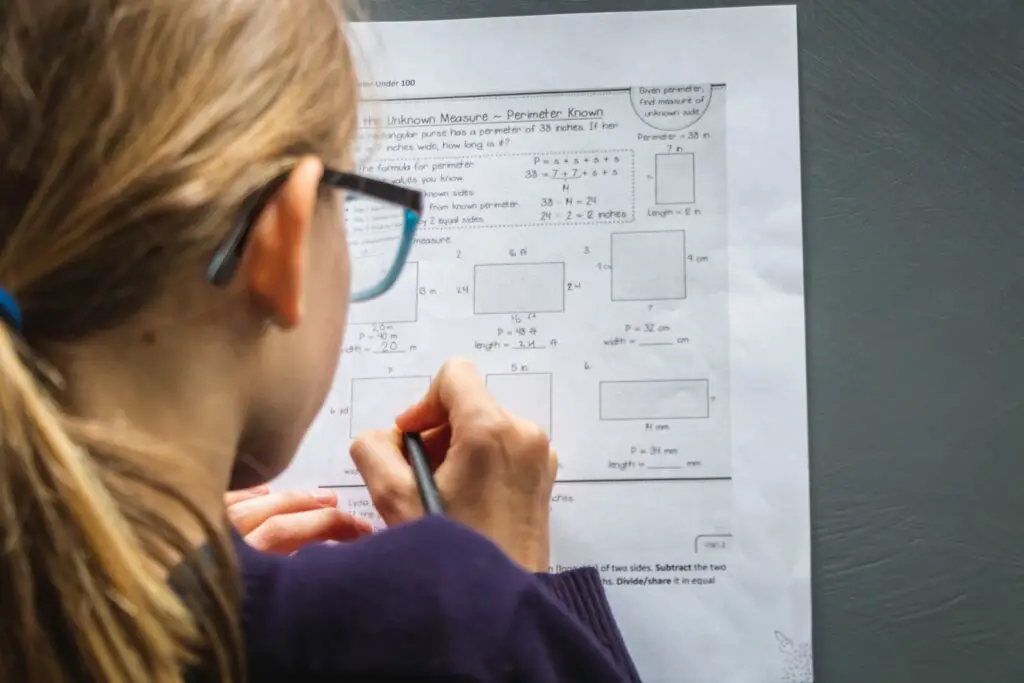
Email Templates – Emailing a Teacher About Homework
Template 1: seeking clarification on homework.
Subject: Clarification Needed for [Assignment Name] Due [Date]
Dear Mr./Ms./Mrs. [Teacher’s Last Name],
I hope this email finds you well. I am [Your Name] from your [Class Name, Period/Session]. I am writing to seek clarification on the [specific aspect] of our current assignment, [Assignment Name], which is due on [Due Date].
I have reviewed the instructions, but I am still unclear about [specific part you are struggling with]. Could you please provide some additional guidance or examples?
Thank you for your time and assistance. I look forward to your response.
[Your Full Name] [Your Class and Section]
Template 2: Requesting Extension Due to Illness
Subject: Extension Request for [Assignment Name] Due to Illness
My name is [Your Name], from your [Class Name, Period/Session]. I am writing to inform you that I have been unwell for the past few days and have been unable to complete the [Assignment Name] that is due on [Due Date].
I have made considerable progress on the assignment, but due to my illness, I am unable to complete it by the deadline. I respectfully request an extension until [Proposed Extended Date] to submit my work.
Thank you for considering my request. I apologize for any inconvenience this may cause and appreciate your understanding in this matter.
Best regards,
Template 3: Asking for Help with Difficult Homework
Subject: Assistance Needed with [Assignment Name]
Hello Mr./Ms./Mrs. [Teacher’s Last Name],
I am [Your Name] from your [Class Name, Period/Session]. I am reaching out because I am having difficulties with [specific aspect] of our homework assignment, [Assignment Name].
Despite reviewing the class notes and textbook, I am still struggling to understand [specific problem or topic]. I would appreciate any additional resources or guidance you could provide.
Could we possibly arrange a time to discuss this further, maybe during your office hours or a free period?
Thank you very much for your help.
Yours sincerely,
Writing an email to a teacher about homework requires clarity, respect, and a willingness to seek solutions. By approaching your teacher with a well-structured email, you can effectively communicate your needs and foster a positive learning environment.


No products in the cart.
- How to write an email to your teacher (with examples)
- Attention/ADHD
- Posted on January 3, 2024
- By Christine
- In Articles , Attention/ADHD , College Readiness

Knowing how write an email to your teacher, professor, or a school administrator in a polite and concise way is a must-have skill. In the fast-paced realm of academics, the art of writing emails is an essential life skill that fosters self-advocacy and responsible communication. While it may seem daunting, fear not – the process is more straightforward than it appears. This article will delve into an easy-to-follow guide with examples that will empower students to navigate this crucial aspect of effective and respectful correspondence.
Step 1: Nail the Subject Line
The subject line acts as the headline, grabbing the recipient’s attention. It should be specific and urgent, making the purpose clear from the start.
Subject: Urgent Math Grade Inquiry
Subject: MacBeth Essay Extension
Subject: Accommodations for ADHD
Step 2: Include a Friendly Greeting
Starting with a friendly greeting sets a positive tone. Using the teacher or professor’s name shows respect and personalizes the email, creating a connection. Make sure you’ve spell-checked the name.
- Hello Mr. Johnson ,
Dear Professor Meyers,
To Whom it May Concern,
Step 3: Introduce the Issue
A brief introduction is like a warm-up. It prepares the reader for what’s coming and shows that you’re not jumping straight to the problem.
- I hope you’re doing well. I wanted to talk about my math test from last week.
- I hope this email finds you well. I’m emailing you regarding an extension for the MacBeth essay due next Friday.
- Good afternoon. I am inquiring to learn more about ADHD accommodations .
Step 4: Provide the Scoop / Go into Detail
Getting into the details is crucial. Keep it real and straightforward, stating the facts to ensure the teacher understands the issue.
- I understand that we were supposed to get our grades back by now, but mine hasn’t shown up. I’m a bit worried about it.
- I came down with the flu last week and was unable to go to the library to finish my research. I’m concerned that my paper doesn’t meet the criteria for the number of primary sources.
- I would like to know what types of accommodations are available for me and how I can start the process of implementing them.
Step 5: Make a polite request
Asking politely is key. Acknowledge the teacher’s busy schedule and add a personal touch, making the request relatable. At the same time, attempt to convey the urgency of the matter.
Could you please let me know when I can expect to see my test grade? It’s stressing me out a bit, especially with finals around the corner.
Would you please consider a 1 week extension for the essay so I can finish my research now that my symptoms have resolved? I can provide a doctor’s note if needed.
Would you kindly guide me through the next steps? Classes start next week so I would like to have everything sorted by Friday.
Step 6: Express Gratitude and Understanding
Expressing gratitude shows maturity. It acknowledges that the teacher has a lot on their plate and emphasizes that the student values their time.
Thanks a bunch for taking the time to help me out. I know you’re super busy, and I appreciate any info you can give.
Thank you for considering my request for a 1 week extension. I know you must be very busy and I appreciate your time.
Thank you in advance for your assistance. I know the beginning of the school year can be very busy and I really appreciate your help.
Step 7: Sign Off with Respect
Ending with a simple “thanks” and your name is like a friendly wave goodbye. It’s respectful and brings a proper close to the email.
Thanks again, Alex
- Thanks again and I hope to hear from you soon, Alex
- Thank you and I look forward to your response, Alex
By following these steps, you’re not just sending an email; you’re building good communication habits and skills of self-advocacy. This way, you can express yourself clearly and respectfully, making sure your voice is heard in any academic situation.
How to Write an Email to Your Teacher (Asking about your grade)
Hello Mr. Johnson,
I hope you’re doing well. I wanted to talk about my math test from last week. So, we were supposed to get our grades back by now, but mine hasn’t shown up. I’m a bit worried about it.
How to Write an Email to Your Professor (Requesting an extension)
I hope this email finds you well. I’m emailing you regarding an extension for the MacBeth essay due next Friday. I came down with the flu last week and was unable to go to the library to finish my research. I’m concerned that my paper doesn’t meet the criteria for the number of primary sources.
Thanks again and I hope to hear from you soon,
How to Write an Email to a School Administrator (Requesting information about ADHD Accommodations)
Good afternoon. I am inquiring to learn more about ADHD accommodations . I would like to know what types of accommodations are available for me and how I can start the process of implementing them.
Thank you and I look forward to your response,
Related Articles
How to Pay for College
Beyond High School (BHS)
Stay Connected with Email Newsletters
Looking for Academic Support and other Educational Services?
You can schedule a free initial consultation to learn more about our services. We will listen to your concerns, answer any questions, learn about the student’s needs, and help guide you through our new student intake process.
Share this:
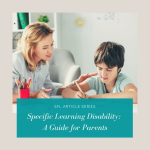
Specific Learning Disability: A Guide for Parents
What is dysgraphia and how to support it.
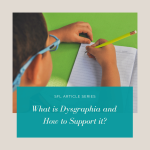
Recommended Posts

How to find an Educational Therapist (What to look for and Questions to ask)

Summer IEP Prep

What is ALTA Certification? (Academic Language Therapists and Practitioners)

Benefits of a Good Summer Learning Plan
- About Katie
- Application Essays
- The Journal
- Join Thousands on My List

How to write an email to your teacher: Tips, rules and examples
Katie Azevedo November 7, 2019 good habits , grades , homework , self advocacy

By Katie Azevedo, M.Ed.
In most situations requiring you to communicate with your teacher, it is best to talk in person. I advise face-to-face meetings when possible because this reduces the chance of miscommunication. In-person meetings also give us the chance to communicate via body language, which is important if you struggle with verbal expression.
However, there are times when face-to-face meetings aren’t possible and you have to write an email instead. For these reasons, you need to know how to write an email to your teacher so that your message is clear and respectful, and also so that you get a response that addresses your concerns.
If your email is unclear and your questions are indirect, you won’t likely get the clear and direct answers you’re seeking — makes sense, right?
Knowing how to write an email to your teacher isn’t just a school-skill; eventually you’ll be writing emails to your boss, to your co-workers, and to other high-rollers. And because you can’t hit “unsend,” you better get it right the first time. If you’re out of school and in the workforce, these email tips, rules and examples apply to you as well.
Okay, onto the rules, the dos and the don’ts.
How to write an email to your teacher (or to your boss, colleague, principal, etc.)
1. Repeat after me: an email is not a text message!!!
2. Repeat after me: an email is not a novel or an epic poem.
3. Always enter in a subject line. Never leave this field blank. Keep it short and to the point, basically like giving your email a “title.” Don’t be creative, don’t use capital letters (no need to SHOUT), and avoid exclamation points unless it’s an actual emergency … in which case….call 911?
Examples of good subject lines:
- Retaking Monday’s test
- Staying after school this week
- Question about tonight’s homework
- Scheduling a time to meet
Examples of terrible subject lines:
- [no subject]
- WHAT DID I MISS???
- i lost my homework and i dont know where to get another copy can you send me another one
4. Use a proper greeting. In fancy language, this is called a salutation. I’m not fancy. In most scenarios, when writing an email to your teacher, you will use “Dear Ms. Smith” – or whatever your teacher’s name is. If you have had your teacher for more than a few weeks, it is okay to use “Hi Ms. Smith.” In either case, always close your salutation with a comma.
Examples of good email greetings:
- Dear Mr. Smith,
- Hi Mrs. Jones,
Examples of bad email greetings:
- What’s up.
5. Introduce yourself. Unless you’re in elementary school and you only have one teacher, the first sentence of your email should clearly and directly state who you are. Don’t skip this step even if your email address contains your name. Keep this information basic and relevant (your teacher/boss doesn’t need to know your shoe size). Do not write more than one sentence.
Examples of good introductory sentences:
- This is Maria Ricci – I am in your A-period chemistry class.
- This is Chrissy Holmes, and I am in your Tuesday night Economics 101 lecture.
6. Write a brief overview sentence. This is an important , simple, single sentence that clearly states why you are writing the email. It should be similar to your subject line. If this sentence doesn’t match your subject line, go back and edit your subject line.
Examples of good overview sentences:
- I’m writing to you because I was absent on Tuesday and I have some questions about what I missed.
- I’m emailing you to follow up about our conversation we had after class yesterday.
- I’m writing to you because I’m looking for some extra help with the material we covered this week.
7. Write the email body. This is where you state your message and/or ask your questions, and is the whole reason you are writing. Be direct, be clear, and be brief. Ideally, this section should be five sentences or less. If you have multiple questions, use bullet points. If your sentences are long, then use extra line breaks (paragraphs) to separate the text into smaller chunks. (See the extra tips below for more about paragraph size and readability.)
8. Thank your teacher/boss and close out the email. Again, keep this part of your email brief.
Examples of good email closures:
Thank you! Sincerely, Meggan Meggles
I appreciate your help. Billy Bob
9. Proof before sending. Don’t skip this step! Read the email aloud to yourself to catch any funky parts, and review the email for spelling errors or word-choice errors. For the love of everything holy, capitalize your “I”s.

Now that you know how to write an email to your teacher (or boss), consider the following tips as well.
1. Keep paragraphs to no more than four-ish sentences each.
2. Limit exclamation points. If you simply MUST use one, limit yourself to one exclamation point per email.
3. Avoid blame and take responsibility. If you’re emailing your teacher about an issue you have with your grade or about a problem you’re having, be careful with your wording. Instead of “I don’t get why you gave me an F!” you could write “I got an F on the assignment, and I’m hoping you could help me understand what I did wrong.” Taking ownership is a much better approach and will increase the chances of your teacher helping you.
4. For high-stakes emails – like if you’re emailing your principal or boss – send the email to yourself first. Doing so gives you one last chance to proof it for dumb mistakes and/or errors in tone.
5. Keep it short. Any email longer than 10-12 sentences is better off as a phone call or an in-person meeting
6. Don’t overdo formatting. Avoid colors, weird fonts, all-capital letters, and excessive bold and italics. An appropriate place to use bold might be to highlight dates and times, like in the following example:
Would you be able to meet with me on Tuesday, November 20th at 2:00 ?
7. Avoid jokes and sarcasm. Save the humor and sarcasm for in-person conversations, as it’s easy for the recipient to misinterpret your tone without hearing your voice or seeing your body language / facial expressions.
Emailing is an effective and efficient form of communication when done correctly. So keep it simple, keep it respectful, and PROOFREAD!
Here are the 4 pillars of email management for students . If you’re overwhelmed in your inbox, follow these 4 steps.
If you struggle with asking for help, here are some key tips for you .
Subscribe to ReportCard Newsletter!
Get your FREE download of 25 School Habits and Hacks when you sign up for our monthly newsletter featuring awesome school tricks and tips
I will never give away, trade or sell your email address. You can unsubscribe at any time.
How to Write an Email to a Teacher (11 FAQs Answered)
When it comes to interacting with academic staff, you can go for a quick face-to-face conversation in most cases. However, if you need your teacher’s help outside of their office hours, it’s best to send them a formal email.
Students usually email their educators for assignment clarification, deadline extension, or help with a specific project. There are plenty of formal email templates online, and we’ll list some of them in this article too.
If you’re trying to figure out how to write an email to a teacher and need to do it for the first time, you’re likely to be confused or anxious about receiving a response. We’re here to help with step-by-step instructions. Keep reading to learn how you should address your teacher, the proper way to write and reply to a formal email, and more teacher emailing tips.
Sending a Mail to a Teacher — Dos and Don’ts
1. how to write a formal email to a teacher.
(Grammar.yourdictionary.com)
Both students and parents may need to correspond with educators occasionally. The formality level applies whether you need to write an absence email to your child’s school, ask about class performance, or have assignment questions as a student. Keep in mind that some tutors may be more easy-going and allow or encourage less formality in the communication.
The general emailing guidelines include using a clear subject line, starting with a correct greeting, ending with a formal salutation, and being respectful throughout. These are just some of the basic instructions on how to write an email to a teacher. Make sure to structure your email as a formal letter and keep it short.
Open up a Word document and type the email there to ensure you don’t accidentally send it before it’s finished. Remember to proofread it. Once you’ve completed the email, send it from your school email address to the email your teacher has given you.
2. How to address a teacher in an email?
(Insidehighered.com)
Now that you are familiar with the basics of writing a formal email, it’s time to move on to specifics.
Your teacher should know what the email is about at first glance. They may receive numerous emails from students, so being straight to the point saves time and makes communication easier. This is why your subject line is important. Moreover, there are certain salutations for teachers that you should use to start an email. For example, you can greet a teacher with a “Hello” or a “Good afternoon.” Remember to add their title and last name.
Avoid writing the email the same way you would text your friends, as it’s not appropriate, even if you’re friendly with your teacher during the class. There’s no need to use abbreviations, and make sure to use correct punctuation, spelling, and grammar.
3. How to start an email to a teacher?
(STEM diversity network)
“Hello” and “Good afternoon” are just examples of formal greetings. “Good morning” or “Dear” followed by your educator’s title and last name are also acceptable. Tip: words like “hey” or “hi” would be too informal.
After an appropriate salutation, you should introduce yourself with your name and class or course. Be mindful of their time and clearly state what they can help you with. If needed, suggest meeting in person for further discussion.
4. How to end an email to a teacher?
(Howtodiscuss.com)
Conclude the email by thanking your teacher for their time, assistance, or advice. Put a formal signature at the very end of your email. A good example of what you can end your email with is “Sincerely,” “Best wishes,” or “Thank you,” followed by your full name.
Once you’ve completed the email, reread it to check its contents, and proofread it. You’re then ready to send it.
5. How to write an email to a professor?
(Academic Positions)
If you’ve already sent emails to your teacher in the past, you’ll notice writing an email to a professor isn’t all that different. Start it off with a proper salutation and be straightforward, but provide enough context so they can remember you and respond to your question faster. Avoid explaining what happened in your personal life and focus on the issue. Sign off appropriately and use your university email address to send it.
6. How to write an email to a teacher asking for something?
(Moviecultists.com)
You may need to email your teacher to ask for notes, help with your assignment, or solve other potential issues with your schoolwork or homework. Asking for something comes down to being polite and concise with your request. If you need to email multiple educators, open up with “Dear professors” or “Greetings.” Make sure to use a proper email format like the one we’ve dissected in the previous sections and end with a formal closing.
7. How to write an email to a teacher about grades?
(World Scholarship Forum)
If you’re struggling in a class, it’s okay to ask your educator to help you get better grades. You can come back to this article at various levels of your education, be it school or college. You don’t need a specific email format to ask about grades. However, you can find a sample email to send to your professor regarding your grade online. Always follow the general emailing guidelines listed here, whether you’re sending an email to a teacher or professor.
The point of emailing your tutor about grades is to find out why you received a poor grade and how to improve it. You can explain that you want to excel or express concern about a grade on a particular paper you wrote. You may ask for a chance to improve your grade through an additional assignment. Remember to add your class details when sending an email to your teacher about your grades.
Students usually ask for an assignment replacement, a chance to get one more grade, or take a grade out of a particular assignment. If you’re concerned about a grade, feel free to ask for clarification, either via email or in person. Keep a respectful tone, avoid blame-shifting, and show that you’re willing to do what it takes to improve.
8. How to email a teacher for a letter of recommendation?
(Cleverism.com)
Whether you’re applying for a graduate program, an internship, or a job, you may need to ask your educator for a letter of recommendation at some point. It’s highly suggested to do this in person, but emailing a professor that knows you well is also a good starting point. Along with your resume and cover letter, a letter of recommendation will set you apart from other candidates and thus increase your chances of getting accepted.
Knowing how to write an email to a teacher is essential, whether you’re asking for grade improvement or a letter of recommendation. Being patient with a reply after you’ve sent it is important, as your educator is busy and will need to take their time writing a quality letter for you. Aim to send a letter of recommendation request at least a month before you’ll actually need it.
9. How to write an email to an old teacher?
(The Life Virtue)
If your past teacher has impacted your life in a meaningful way, you may want to thank them for everything they’ve done for you. You already know the basics of corresponding with academic staff. While maintaining a respectful tone is still necessary, writing to your old teacher is also an opportunity to express a more personal side of things in a positive manner.
A thank you email to your teacher should be proper, since it allows you to expand on what you’re thanking them for. It doesn’t have to be short and straightforward. You can write about how your tutor has inspired you, directed you, or changed you for the better. You can thank them for being a good role model or helping you discover your hidden talents.
When emailing a former teacher to say thank you, you can incorporate any thoughts of appreciation. Feel free to make it a heartfelt thank you letter. In addition to what we’ve already mentioned, they may have helped you polish a skill or pushed you to be the best you could be. If they understood and encouraged you to face a problem during your education, you can include that as well.
10. How to respond to a teacher email?
(Eliteprep.com)
Whether you’re communicating with a teacher or a college professor, you should reply once you receive their response. Remember to start with a salutation and end with an appropriate signature, just like you did in your initial email. Use correct spacing to avoid creating a hard-to-read block of text. Replying to the response ensures you’re formally thanking the tutor for taking the time to respond and give you the information you need.
11. When is it not ok to write an email to a teacher?
(Bid4papers.com)
We’ve covered a list of good reasons to send an email to your teacher. You’ve learned that you shouldn’t burden an educator with personal problems and excuses. You can send an email about a specific question anytime, but teachers generally respond in the early morning or after students leave school.
As long as you aren’t rude and know the proper way to email a teacher, you can ask about almost anything you need help with. However, discussing other students and making excuses for not doing a test are highly inappropriate. This also applies to asking for deadline extensions or extra credits when you haven’t been doing your schoolwork.
Knowing how to write an email to a teacher is a skill you’ll need throughout your education, so it’s best to learn early on. Most emails sent to educators are centered around specific questions. However, some email types may give you more leeway to interact with academic staff more informally. Thanking an old teacher or professor is an opportunity to express your gratitude for their positive influence on you during your studies. Being less formal with your current teacher is acceptable if they give you the green light to do so.
Grammar.yourdictionary.com Insidehighered.com STEM diversity network Howtodiscuss.com Academic Positions Moviecultists.com World Scholarship Forum Cleverism.com The Life Virtue Eliteprep.com Bid4papers.com

Grammar check | Essay checker | Writing checker
February 15, 2019
What should I write in an email to my teacher?
by Nicholas Walker , under Writing skills

Students aren’t often aware of the impact of their emails on their teachers. Well-written emails strengthen the relationship. Poorly-written emails will arouse resistance and opposition. You don’t want that.
Teachers are committed to helping students succeed and prosper. Really.
It only makes sense for students to learn to write emails that maximize their chances of getting the help and support they want and need from the people who want to help and support them.
Here are a few things to keep in mind the next time you send an email to your teacher.
- Write your email in English. English teachers like that.
- Write an information-rich subject line: Online quiz problem in Lesson 4
- Begin with a salutation followed by a comma: Dear Professor Walker,
- Show some concern for the person reading the email: I hope you are having a good day.
- Remind your teacher how he knows you: I’m in your Monday 8-11 class.
- Say why you are writing your email: I am writing this email to tell you about a problem I am having and to ask you for your help.
- Be specific and get to the point: For some reason, I wasn’t able to do the online reading quiz on Labodanglais.com in Lesson 4. The quiz closed without warning, and it gave me a score of zero.
- Politely say what you want: Could you reset the quiz for me when you get the chance?
- Show some gratitude: I would really appreciate it.
- Say when you will contact the teacher again: See you in class on Monday.
- Close with a standard greeting: Best wishes,
- Add your name: Justin Trudeau
- Check your email for errors using the Virtual Writing Tutor grammar checker .
SUBJECT: Online quiz problem in Lesson 4 Dear Professor Walker, I hope you are having a good day. I’m in your Monday 8-11 class. I am writing this email to tell you about a problem I am having and to ask you for your help. For some reason, I wasn’t able to do the online reading quiz on Labodanglais.com in Lesson 4. The quiz closed without warning, and it gave me a score of zero. Could you reset the quiz for me when you get the chance? I would really appreciate it. See you in class on Monday. Best wishes, Justin Trudeau
Don’ts
- Don’t forget any of the steps listed above.
- Don’t repeat any of the steps listed above in any subsequent exchanges. It usually isn’t necessary since the email thread will contain all of the previous pleasantries.
Big mistakes students make
Some students write their emails angry and confused.
You can imagine a student suddenly feeling very needy and a little annoyed while doing his or her homework. Something went wrong. Because of the pressure that student feels, he or she decides to get help from the teacher with a particular problem. However, instead of thinking how to get the teacher to sympathize and then assist with the problem, the student decides to share his or her annoyance and complain.
The website bugged on me and gave me zero on a quiz. I am not happy.
Many teachers will simply choose to ignore an impolite student’s email. Other teachers will engage. I tend to engage. I figure that I have a job to do. The student obviously doesn’t know how to communicate effectively in English, I have made a commitment to assist students outside of the classroom with office hours and emails, so it is my job to help students communicate. I might ask a few pointed questions.
Who are you? Why are you being so rude? Which website? Which quiz? Which course? Which group? What do you want? Best wishes, Nicholas Walker
I realize that the tone of such a reply is rather hostile, but I’m no pushover. The student wanted a frank exchange. Wish granted.
The real issue is this. Whether your teacher responds or not, the opportunity to build and strengthen the relationship between the teacher and the student will have been lost. Now, the relationship is infused with annoyance and frustration on both sides.
The big solution
If you are a student, learn how to write a proper email. You will get better results.
If you are a teacher, take a minute to communicate your expectations. If this blog post helps, please feel free to share it.

Want more like this?
Get new posts by email, recent posts.
- ConverSolo to Provide AI Language Learning Tools to Quebec Colleges and University– A First of its Kind AI Application in Higher Learning
- Virtual Writing Tutor Membership Plan Options
- Automated Essay Scoring Moodle Plugin
- 30 conversation questions to ask a traveler or a voice-enabled chatbot
- Inflation for ESL students
- Improve Writing
- What’s my English level?
- Automatically Scored Emails
- ESL Strategies: Flashcards
- Applied Linguistics at Concordia University
Enjoy this blog? Please spread the word :)

How to write an email to a teacher
In today’s world, email communication has become an essential aspect of modern-day communication. Emails are widely used for professional communication as well as personal communication. As a student, you may have had to send an email to your teacher at some point in your academic career. Whether you are asking for an extension, clarifying a doubt, or introducing yourself, there are certain guidelines that you should follow while writing an email to a teacher. In this article, we will discuss how to write an email to a teacher and how to optimize the content for search engine optimization (SEO) purposes.
Table of Contents
Step 1: Determine the Purpose of Your Email
Before you start writing your email, it is crucial to understand the purpose of your email. Do you want to ask for an extension on an assignment, or do you need to clarify a doubt about the course material? Understanding the purpose of your email will help you structure your email clearly and concisely.
- Dear Mrs. Smith, My name is John Doe, and I am a student in your 9th-grade English class.
- Good morning, Mr.Johnson, I hope this email finds you well. My name is Sarah Brown, and I am a student in your Biology class.
- Hello Mrs. Rodriguez, My name is Alex Hernandez, and I am a parent of one of your students, Maria Hernandez, in your 5th-grade class.
- Good afternoon, Coach Johnson, My name is Tom Wilson, and I am a student-athlete on the varsity basketball team.
- Dear Mr. Lee, My name is Emily Chen, and I am the parent of a student in your 11th-grade History class, Henry Chen.
Step 2: Choose a Clear and Concise Subject Line
The subject line of your email is the first thing your teacher will see when they receive your email. A clear and concise subject line will help your teacher understand the purpose of your email before they even open it. Your subject line should be specific and to the point. For example, if you are asking for an extension on a project, your subject line could be “Request for Extension on Project X.”
How to write an email to a teacher | Examples of subject lines
- Request for Extension on [Project/Assignment Name]
- Question About [Topic/Assignment Name]
- Absence Notification for [Date/Class Name]
- Follow-up on [Class Name] Discussion
- Meeting Request for [Date/Time/Topic]
- Request for Feedback on [Project/Assignment Name]
- Assistance Needed with [Task/Assignment Name]
- Question Regarding [Class/Topic Name]
- Request for Meeting to Discuss [Topic/Assignment Name]
- Feedback on [Class/Assignment Name]
- Request for Office Hours Meeting
- Inquiry about [Textbook/Reading Material]
- Clarification on [Class/Assignment Name]
- Question about Upcoming Exam/Quiz
- Request for Letter of Recommendation
- Notification of Technical Difficulties During [Class/Assignment Name]
- Follow-Up on Missed [Class/Assignment Name]
- Request for Extra Help or Tutoring
- Inquiry about Course Requirements/Expectations
- Notification of Absence on [Date/Class Name]
- Request for Approval for [Project/Assignment Name]
- Request for Additional Resources or Materials
Step 3: Use a Professional Greeting
When addressing your teacher, it is important to use a professional greeting. If you are unsure of your teacher’s preferred title, you can use “Dear Professor/Teacher [Last Name]. Always use the teacher’s last name. Avoid using informal greetings like “Hey” or “Hi” as they may come across as disrespectful.
Step 4: Introduce Yourself
If you are writing to your teacher for the first time, it is a good idea to briefly introduce yourself. You can mention your name, the class you are taking, and any relevant information that will help your teacher understand who you are. Keep this introduction brief, as your teacher likely already has your name and basic information.
Step 5: Clearly State the Purpose of Your Email
In the body of your email, clearly state the purpose of your email. If you are asking for an extension, explain why you need the extension and when you would like to submit the project. If you are asking for clarification on a class topic, be specific about what you need clarification on. It is crucial to be clear and concise in your email to avoid any confusion.
How to write an email to a teacher | Examples of stating your request
- I am writing to request your assistance with the homework for this week’s math assignment. I am having trouble understanding some of the concepts we went over in class, and I was hoping you could clarify some of the questions for me.
- I was hoping to schedule a meeting with you to discuss my daughter’s progress in your class. Would it be possible to schedule a time this week to meet with you?
- I am writing to request clarification on the reading assignment for this week’s English class. I am having trouble understanding the instructions, and I was hoping you could provide some guidance.
- I am reaching out to request an extension on the upcoming essay assignment. I have encountered some unexpected personal circumstances that have made it difficult to focus on my coursework, and I was hoping to ask for a few extra days to complete the assignment.
- I am writing to report an incident of bullying that occurred in your class yesterday. I witnessed a student being verbally harassed and bullied by another student, and I believe it is important to bring this to your attention.
- I am reaching out to request an extension on the upcoming homework assignment. I have encountered some unexpected personal circumstances that have made it difficult to focus on my coursework, and I was hoping to ask for a few extra days to complete the assignment.
Step 6: Use Proper Grammar and Spelling
Your email should be written in proper English with correct grammar and spelling. Avoid using slang or informal language. Proofread your email before sending it to ensure that there are no typos or grammatical errors.
Step 7: End Your Email Professionally
End your email professionally with a closing statement and your name. A common closing statement is “Thank you for your time and consideration.” Sign off with “Sincerely” or “Best regards” followed by your name.
- Thank you for your time and consideration.
- I appreciate your assistance and look forward to your response.
- If you have any further questions, please do not hesitate to contact me.
- I will follow up with you in [timeframe] to ensure that everything is in order.
- I am grateful for the opportunity to learn from you.
- I look forward to [upcoming event/class/meeting].
In conclusion, emailing your teacher can be a daunting task, but by following these guidelines, you can write a professional and effective email. Remember to determine the purpose of your email, use a clear and concise subject line, use a professional greeting, briefly introduce yourself if necessary, clearly state the purpose of your email, use proper grammar and spelling, and end your email professionally.
More related Email templates
- 25 Professional Teacher Email Examples
- Missing Assignment Email to Teacher: 25 Example Emails
- Positive Email to Parents from Teacher: 15 Example Emails
Related Posts

15 Sample Leave Letter for Personal Reason

How to Write an Enquiry Email to University | 23 Email Templates

The Art of Crafting the Ideal Welcome Email for New Employees

Sample List of Accomplishments for Performance Review

How to send a follow up email after no response | 7 Customizable Templates
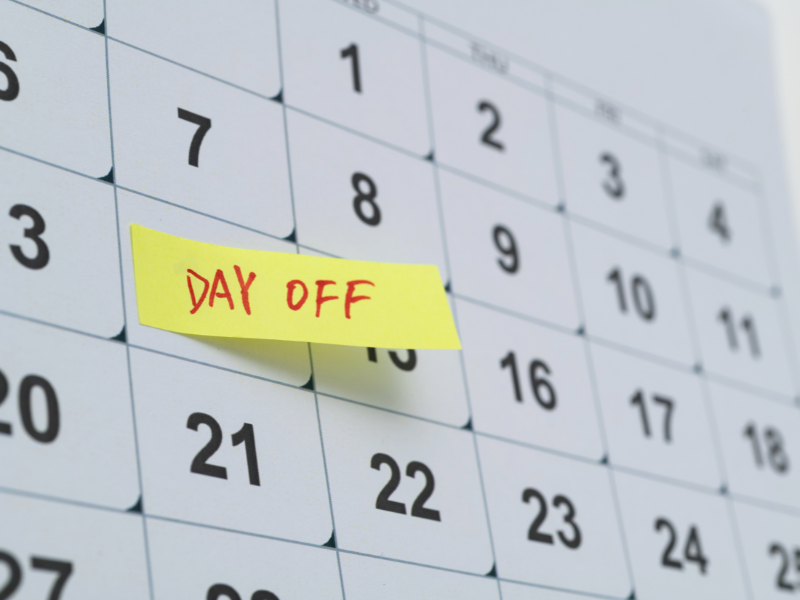
Request Day off Email Sample Templates | 39 Examples

How to email a teacher about an assignment
In our student life, we need to write an email to the teachers regarding our assignments, projects, and other reasons. Hence, if you are looking at how to email a teacher about an assignment, we will provide you proper guidance on it, and you have to follow it step by step to email your teacher. Apart from this, we will serve you email samples so that you can get an idea from them.
Are you struggling with your assignment? then you don’t have to worry about it because we have a team of experts who provide the best & top-notch assignment help online service at an affordable price.
Steps to email your teacher-
Table of Contents
For a professional email, you have to follow these steps-
Make your mind-
Your first step is to be sure that you need to email your teacher about an assignment. If you face any problem while writing your assignment and can not seek a solution to other sources, you can email your teacher in respect of that question.
But initially, you should try to get the answer from your friends and other online sources because your teacher does not have much time to answer your question.
Your teachers have many responsibilities to handle, but if you are unable to get the answer and email is the last option, you don’t need to think a lot; email your teacher and ask his or her favor.
Use a professional email id-
It will be looking unprofessional if you use a non-educational or unprofessional email address. Use an email address that is appropriate for academic purposes. For example, you are using the email address have fun##[email protected]. It is an unprofessional id for educational purposes. It should be like [email protected], and it should include your first name and last name and then the domain of your id.
Include a clear subject line-
Your subject line tells the reader what your question is? and what you are going to ask your teacher. If you don’t know how to email a teacher about an assignment with an unambiguous subject, you can check the format online and ask your friends and peers. It should involve the course name and your query regarding the course. For instance-
- Query regarding (chemistry) assignment
- (Biology)- want to do a meeting
Use impressive email greeting-
Do not forget you are writing an email to your teacher so you must use greeting words for the teacher. Write the proper name of your teacher, and a comma should follow it. Do not use informal words like ‘hey, ‘what’s up’. Always use Dear Professor (last name). One more thing you have to remember: don’t call your teacher with his or her first name unless they allow you to do so. Write your email in a polite form.
If your teacher is Ph.D. then use Dr. before his or her name like-
Dear/Dr./Professor/Mr./Mrs./Ms. (last name). Dear Dr. Johnson Dear Mrs. Karlo
Do not forget to mention your name-
A teacher has to handle many students in his job tenure, and it is not always possible to remind individuals’ names. To save the recipient time and respond fastly, it is advisable to mention your name and course. You can write as-.
My name is Marry Carlo, from Chemistry 1D, Section 2.
Be straightforward in the body text-
Now it’s time to put your query and request in the body text after greeting the teacher and writing your name. Make a simple and clear statement so the reader can understand it without any hitch. When he or she is able to understand your point of what you are trying to convey, the teacher can give you a clear response.
Avoid extra sentences in your body and focus on your question because your teacher does not have unlimited time to read the irrelevant sentences in your body. Write your body text concisely.
For instance- I am facing problems regarding the Chemistry assignment , and I am confused about the chemical reaction. I want to meet you if you have time.
Come to an end-
Now politely end your email and leave a professional signature at the bottom of the text. For example, you can write-
Thank you for your valuable time, and have a nice day. Obediently, Marry Carlo
Do proofreading-
Now revise your text and make sure you have written the email in a formal context because now you know how to email a teacher about an assignment. Check your grammar, spelling, and punctuation mistakes and correct them. To quickly do so, get help from a grammar checker . Utilizing the tool will completely eliminate the need for you to manually find and fix grammar mistakes in the email. Remove extra words from your text. Apart from this, avoid emojis and other informal words. Do not make your text complex and unclear.
Ask your teacher’s email address
Now your email is ready, but before sending it, you need your teacher’s email address. You can ask your teacher for the email address, and you can get it from other students, teachers, and even from the parents.
Click send button-
Now, after editing and getting the teacher’s email address, click the send button and check if it is sent or not; if yes, be patient for the reply; otherwise, click the retry button.
If you have to email your teacher for a letter of recommendation-
You can use this sample when you are looking for a recommendation from your teacher for the future. And give time to your teacher so that he can think about it and can give you a good recommendation.
From – sender’s email address
Date -Current date
To – Recipient’s email address
CC – When you have to send the email to more than one person, write their email address here otherwise leave this area blank.
Subject – Letter of Recommendation for………..
Dear Sir (last name),
My name is Marry Carlo. I was a student of (course name) in ABC school or college. Now I am thinking of joining an internship summer program for graduates at(place name). I appreciate your efforts in my growing time as a student. I need a recommendation letter for it, so i will be very thankful to you for writing it for me. I have attached the required documents file for reference.
I am waiting for your response.
Yours faithfully Marry Carlo
So the above sample of how to email a teacher about an assignment is sufficient. You can mold your answer according to your subject and situation.
When you have to fix the meeting with the teacher-
If there is a need to fix the meeting with the teacher regarding your assignment.
Subject- Meeting about(problem)
Dear Sir (last name)
My name is Rosemary, and I am studying in(course name) in the ABC college.I started to write my assignment for (topic name) and I have a query to check my command on the topic. I am confused between two terms(name those terms). I want to clear my doubt by discussing face to face, so if you have time, could I meet you in your office.
I am waiting for your valuable response.
Yours Sincerely Rose Marry
Some Do’s and Don’t of an email writing to teacher –
If you want to know how to email a teacher about an assignment in an effective way then you have to take care of some points.
Do’s-
- Email your teacher when necessary.
- Make a clear subject line.
- Write your email politely.
- Make it concise.
- Use salutations
- Use formal words or sentences
- Do editing before submitting.
Don’t-
- Do not over-explain your problem or query.
- Do not send emotional emails to your teacher.
- It is not recommended to communicate everything through email.
- Do not use complex or obscure sentences in your body text. keep it simple.
- Do not use casual words like Hey and what’s up.
- Don’t panic to get the response of your teacher. Give him or her time.
Conclusion-
Email is a fast and cheap mode of communication. It involves composing, sending and storing, and receiving messages. We use email for different purposes, and in student life, we have to send emails to our teachers and other students. Especially when you get assignments from your teachers, you should know how to email a teacher about an assignment because it can affect your academic grades. So follow the ways we discussed earlier to mail your teacher.
Similar Articles

How To Do Homework Fast – 11 Tips To Do Homework Fast
Homework is one of the most important parts that have to be done by students. It has been around for…

How to Write an Assignment Introduction – 6 Best Tips
In essence, the writing tasks in academic tenure students are an integral part of any curriculum. Whether in high school,…
Leave a Comment Cancel Reply
Your email address will not be published. Required fields are marked *
This site uses Akismet to reduce spam. Learn how your comment data is processed .
How To Write Email To Teacher

- How-To Guides
- Tech Setup & Troubleshooting

Introduction
Welcome back to school! As you settle into your new academic year, it’s only natural that you will have questions, concerns, or even the occasional need for clarification. Fortunately, email provides a convenient and efficient way to communicate with your teachers. However, crafting an email to a teacher requires a different approach than writing to a friend or family member. In this article, we will explore some essential tips on how to write an email to your teacher effectively.
Whether you’re seeking guidance on an assignment, requesting a meeting, or addressing any other academic matter, it’s crucial to express yourself clearly and professionally. By adhering to a few basic guidelines, you can ensure that your message is respectful, concise, and easy to understand.
In the following sections, we will discuss specific strategies to help you construct an email that will make a positive impression on your teacher. We will cover important aspects such as the proper greeting, subject line, tone, content, and proofreading. By mastering these skills, you will not only demonstrate professionalism but also increase the chances of receiving a prompt and helpful response.
So, whether it’s a simple question or a complex problem, let’s dive into the art of writing an effective email to your teacher. By the end of this article, you’ll have the tools you need to confidently communicate with your instructors, forging a strong and productive academic relationship.
Start with a Polite Greeting
When composing an email to your teacher, it’s important to begin with a polite greeting. This sets a respectful and friendly tone from the outset and shows your teacher that you value their time and expertise. Addressing your teacher using the appropriate title, such as “Dear Professor Smith” or “Hello Mr. Johnson,” demonstrates your understanding of proper etiquette.
Keep in mind that the formality of your greeting may vary depending on the teacher’s preferences and the nature of your relationship. It’s always best to err on the side of formality unless instructed otherwise.
In cases where you are less familiar with the teacher, or if you are addressing multiple teachers in the same email, a generic salutation such as “Dear Faculty” or “Dear Teachers” can be appropriate. However, it’s always ideal to address the recipient by name whenever possible.
Remember to use a polite and respectful tone throughout your email. Avoid using overly casual language, slang, or abbreviations that may come across as disrespectful or unprofessional.
Here’s an example of an appropriate greeting:
Dear Professor Johnson,
Starting your email with a polite greeting not only establishes a positive tone but also shows your teacher that you value their time and expertise.
Use a Clear and Descriptive Subject Line
When writing an email to your teacher, a clear and descriptive subject line is essential. The subject line should succinctly summarize the purpose or main topic of your email. This allows your teacher to quickly identify the content and prioritize their responses accordingly.
Avoid vague or generic subject lines like “Question” or “Help Needed.” Instead, provide specific information that accurately reflects the nature of your email. For example, if you are seeking clarification on a homework assignment, a subject line such as “Question about Homework Assignment Due on [Date]” would be more informative and helpful.
Using a clear subject line also allows your teacher to search for and reference your email in the future, making it easier to locate important information or follow up on previous discussions.
Here are some tips for crafting an effective subject line:
- Be specific: Clearly state the main topic or purpose of your email.
- Keep it concise: A subject line should ideally be no more than a few words or a short sentence.
- Avoid using unnecessary words or symbols: Only include relevant information to keep the subject line clean and easy to read.
- Use keywords: Include important keywords related to the subject matter to make it easier for your teacher to categorize and search for your email.
Remember, an informative subject line not only helps your teacher understand the content of your email at a glance but also increases the likelihood of a prompt and precise response.
For example, let’s say you are requesting a meeting with your teacher to discuss an upcoming exam. A concise and descriptive subject line could be:
Request for Meeting to Discuss Exam Preparation
By using a clear and descriptive subject line, you ensure that your teacher understands the purpose of your email right away, leading to more effective communication.
Address the Teacher Appropriately
When writing an email to your teacher, it’s important to address them appropriately. How you address your teacher sets the tone for your communication and shows respect for their role as an educator.
Start by using the correct title and surname. If you are unsure about how to address your teacher, it’s best to use a formal title such as “Professor,” “Doctor,” or “Mr./Ms./Mrs.” followed by their last name. For example, “Dear Professor Johnson” or “Hello Dr. Smith.”
However, if your teacher has explicitly stated their preference for a different form of address, such as first name or a specific title, it’s important to use that instead. Pay attention to any instructions provided by your teacher or refer to how they introduce themselves in class or on course materials.
Remember to double-check the spelling of your teacher’s name and ensure that you are using the correct form of address. Using the wrong name or title can be perceived as disrespectful or inattentive.
In some cases, you may have a more informal or friendly relationship with your teacher. If this is the case and they have given you permission to use their first name, you can address them by their first name in your email. However, be cautious and considerate when deciding to adopt a more informal tone. Maintain a level of respect and professionalism throughout your communication.
Here’s an example of how to address your teacher appropriately:
Addressing your teacher with the appropriate title and surname shows respect and professionalism. It’s important to follow their preferred form of address or use a formal title and last name if no specific preference is given.
State the Purpose of Your Email
When writing an email to your teacher, it’s crucial to clearly state the purpose of your communication. Clearly articulating why you are reaching out helps your teacher understand the context and importance of your email and facilitates a more targeted response.
In the opening paragraph of your email, briefly mention the main reason for contacting your teacher. This could be a specific question, a request for clarification, a need for additional resources, or any other academic matter you would like to address. Be concise and specific in your wording to ensure that your teacher understands the purpose of your email.
Avoid burying your main point in lengthy paragraphs or unrelated content. Instead, prioritize clarity and brevity to convey your intentions effectively.
If you have multiple topics to discuss, consider using bullet points or numbering to organize your thoughts. This helps your teacher understand the different points you want to address and ensures that nothing gets overlooked.
Here’s an example of how to state the purpose of your email:
I hope this email finds you well. I am writing to request clarification on the requirements for the upcoming research paper in your English literature class. Specifically, I would like to better understand the expectations for the length, sources, and formatting of the paper. Additionally, I would appreciate any guidance you can provide regarding the recommended research process and potential sources to explore.
By clearly stating the purpose of your email, you set the foundation for a focused and productive conversation with your teacher.
Be Concise and to the Point
When writing an email to your teacher, it’s important to be concise and get straight to the point. Teachers are often busy with various responsibilities, so keeping your email concise demonstrates respect for their time and allows them to easily understand and respond to your message.
Avoid rambling or including irrelevant details. Instead, focus on clearly expressing your main point or question in a few sentences or short paragraphs. Use clear and straightforward language to convey your message effectively.
To maintain clarity and conciseness:
- Stick to the topic: Stay focused on the purpose of your email and avoid going off on tangents.
- Use bullet points or numbered lists: If you have multiple points or questions to address, organize them in a concise and structured format.
- Avoid unnecessary repetition: Make sure each sentence and paragraph adds new information or contributes to your main point.
- Keep paragraphs short: Break down your thoughts into smaller paragraphs for easier reading and comprehension.
Being concise doesn’t mean sacrificing politeness or omitting necessary details. However, it’s crucial to find a balance between providing enough information and overwhelming your teacher with excessive text.
Here’s an example of how to be concise and to the point:
I hope this email finds you well. I wanted to follow up on our recent discussion in class about the upcoming group project. My group members and I would like to request an extension of two days for the project submission deadline due to unforeseen circumstances. We believe this additional time will allow us to deliver a more comprehensive and polished project. Thank you for considering our request, and we look forward to your guidance regarding the revised deadline.
By being concise and direct in your email, you respect your teacher’s time and increase the likelihood of receiving a prompt and efficient response.
Provide Necessary Information and Context
When writing an email to your teacher, providing necessary information and context is crucial for effective communication. By including relevant details and explaining the background or circumstances surrounding your inquiry, you help your teacher better understand your situation and provide an appropriate response.
Start by briefly outlining any relevant assignments, topics, or discussions that relate to your email. This helps your teacher connect your message to the appropriate context and ensures that they have the necessary information to address your concerns.
If you are seeking clarification on a specific assignment or class material, provide specific references, such as the assignment number or the date the topic was discussed. This allows your teacher to pinpoint the information you are referring to and provide accurate and targeted guidance.
Additionally, if you have attempted to find the answer to your question or resolve the issue independently, mention your efforts in your email. This shows your initiative and willingness to problem-solve, which your teacher will appreciate.
However, avoid overwhelming your teacher with excessive information or unnecessary background details. Stick to the relevant facts and keep your explanations concise.
Here’s an example of how to provide necessary information and context:
I hope you’re doing well. I’m writing to seek further clarification on the recent lecture about the laws of thermodynamics. During the lecture, you mentioned the concept of entropy and its relationship to energy transfer. I’ve reviewed my notes and textbook, but I’m still struggling to grasp the concept. Could you please provide some additional examples or resources that could help me better understand how entropy relates to energy transformations? I’ve also attempted to research online, but I haven’t found any explanations that resonate with me. Any guidance you can provide would be greatly appreciated.
By providing necessary information and context, you help your teacher understand the specific area in which you’re seeking assistance, increasing the chances of receiving a clear and helpful response.
Use Proper Grammar and Spelling
When writing an email to your teacher, it’s essential to use proper grammar and spelling. A well-written email demonstrates your professionalism and attention to detail, leaving a positive impression on your teacher. Clear and error-free communication also helps ensure that your message is easily understood.
Take the time to proofread your email before sending it. Check for any spelling or grammatical errors. Review your sentences for clarity, and make sure your thoughts are expressed in a coherent and organized manner. Consider using tools like grammar and spell-checkers to assist you in spotting any mistakes.
Be mindful of commonly confused words, such as their/there/they’re, your/you’re, or its/it’s. Using these words correctly contributes to the overall clarity and coherence of your email.
When in doubt about the proper usage of a word or phrase, consult a reliable reference source, such as a dictionary or grammar guide. You can also ask a trusted peer or teacher to review your email before sending it to ensure that your writing is clear and error-free.
If English is not your first language, it’s even more important to double-check your grammar and spelling. Taking the time to communicate effectively in English shows your dedication to improving your language skills and your respect for your teacher’s linguistic expectations.
Here’s an example of an email with proper grammar and spelling:
I hope you are well. I am writing to inform you that I will be unable to attend the afternoon lecture on Monday, October 18, as I have a doctor’s appointment scheduled during that time. I apologize for any inconvenience this may cause. Could you please let me know if there will be any important material covered during the lecture that I should review independently? I appreciate your understanding and assistance.
By using proper grammar and spelling, you ensure that your email is clear, professional, and easily understood by your teacher. Taking the time to proofread and edit your email before sending it demonstrates your attention to detail and commitment to effective communication.
Include Attachments or Relevant Documents
When writing an email to your teacher, it’s important to include any necessary attachments or relevant documents to support your inquiry or request. Including these materials can provide additional context and clarity, making it easier for your teacher to understand the purpose of your email and provide a thorough response.
If you are referencing a specific assignment or project, attach the relevant documents to your email. This could include assignments guidelines, rubrics, completed worksheets, or any other materials related to the assignment or project.
If you are seeking clarification on a particular topic, consider attaching screenshots, images, or excerpts from your textbook or online resources to illustrate your question or to provide additional context.
When attaching files, make sure they are in the appropriate format and are named appropriately. Use clear and concise file names that accurately describe the content. For example, instead of using generic names like “file1” or “document,” use descriptive titles such as “Smith_John_Research_Paper_Final_Draft” or “Math_Quiz_Chapter5_Solutions.”
Including attachments not only helps your teacher better understand your inquiry or request but also shows your attention to detail and preparedness in providing all necessary information for a complete conversation.
Here’s an example of how to mention attachments in your email:
I hope this email finds you well. I am writing to inquire about my recent test results. I have attached my graded test paper, as well as the class syllabus for reference. I noticed a discrepancy between my answers and the marks awarded for some questions, and I would appreciate your guidance to clarify the correct solutions. Thank you in advance for your help.
By including attachments or relevant documents, you provide your teacher with the necessary materials to address your inquiry or request accurately and comprehensively.
Be Respectful and Avoid Inappropriate Language
When writing an email to your teacher, it’s crucial to maintain a respectful and professional tone. Treating your teacher with respect not only fosters a positive and productive relationship but also reflects well on your own character and maturity as a student.
Ensure that your language is always courteous and appropriate. Avoid using slang, offensive or derogatory terms, or any language that could be perceived as disrespectful or inappropriate. Maintain a polite and formal tone throughout your email, even if you have a more casual relationship with your teacher.
Remember to use proper language and avoid using excessive capitalization, excessive exclamation marks, or a confrontational tone. Be aware of the impact of your words and take the time to consider how your email may be interpreted by your teacher.
If you have a disagreement or concern, express it in a respectful and constructive manner. Avoid becoming defensive or accusatory in your language. Instead, focus on expressing your thoughts and concerns with a calm and rational approach.
Here’s an example of how to maintain a respectful tone in your email:
I want to express my appreciation for the effort you put into preparing the lecture on Newton’s laws of motion. However, I have a few concerns regarding the pace of the lecture. I found it challenging to process all the information in such a short period, particularly during the examples provided. Could you kindly consider slowing down the lectures or providing additional practice resources to help reinforce the concepts? Thank you for your attention to this matter.
By maintaining a respectful tone and avoiding inappropriate language, you create a positive impression and foster a respectful and productive relationship with your teacher.
Proofread and Edit before Sending
Before sending your email to your teacher, it’s crucial to proofread and edit your message. Reviewing your email for errors and making necessary adjustments ensures that your communication is clear, polished, and professional.
Start by checking for grammatical and spelling errors. Read through each sentence carefully, making note of any mistakes or typos. Correct any errors to ensure that your email is error-free and easy to understand.
Check for clarity and coherence in your email’s content. Make sure your thoughts are organized and presented in a logical manner. Review your sentences and paragraphs for coherence, ensuring that each idea flows smoothly into the next.
Consider the tone and language used in your email. Ensure that your message remains polite, respectful, and appropriate at all times. If needed, make revisions to enhance the clarity and professionalism of your writing.
Pay attention to the overall structure of your email. Ensure that your paragraphs are well-organized and that your ideas are expressed in a sequential and coherent manner. If necessary, reorganize your thoughts to create a more effective flow of information.
Take a moment to read your email from the perspective of your teacher. Ask yourself if all the necessary information is included, if your questions are clear, and if your email conveys the intended message accurately.
Consider seeking the assistance of a trusted friend, family member, or classmate to proofread your email. Fresh eyes can often catch errors or suggest improvements that you may have overlooked.
Here’s an example of how to emphasize the importance of proofreading before sending your email:
I hope this email finds you well. I wanted to inquire about the upcoming group presentation scheduled for next week. As I reviewed our presentation outline, I realized that there may be an error in the due date for the PowerPoint slides. It currently states that the presentation is due on November 15th, which conflicts with the information discussed in class. Could you please confirm the correct due date? I apologize for any confusion this may cause. Thank you for your attention to this matter.
By proofreading and editing your email before sending, you ensure that your message is clear, error-free, and professional. Taking the time to review and revise your email demonstrates your commitment to effective communication with your teacher.
Writing an email to your teacher is an essential skill that can greatly benefit your academic experience. By following these guidelines, you can effectively communicate your needs, concerns, or questions while maintaining a respectful and professional tone.
Remember to start your email with a polite greeting and use a clear and descriptive subject line to convey the purpose of your email. Address your teacher appropriately and state the purpose of your email concisely and directly. Provide necessary information and context, ensuring that your teacher has the background knowledge required to assist you.
It is crucial to use proper grammar and spelling to demonstrate your professionalism and attention to detail. In addition, include any relevant attachments or documents to support your inquiry or request.
Always maintain a respectful and courteous tone throughout your email, avoiding inappropriate language or confrontational attitudes. And finally, before hitting that send button, take the time to proofread and edit your email to ensure it is error-free and effectively conveys your message.
By mastering the art of writing a thoughtful and well-crafted email to your teacher, you can establish strong lines of communication, foster positive relationships, and enhance your academic experience. Effective email communication will not only help you receive the support and guidance you need but also showcase your professionalism and commitment to success.
So remember, the next time you have a question or concern, don’t hesitate to compose a well-crafted email to your teacher. By following these guidelines, you’ll be on your way to effective and respectful communication in no time.
Leave a Reply Cancel reply
Your email address will not be published. Required fields are marked *
Save my name, email, and website in this browser for the next time I comment.
- Crowdfunding
- Cryptocurrency
- Digital Banking
- Digital Payments
- Investments
- Console Gaming
- Mobile Gaming
- VR/AR Gaming
- Gadget Usage
- Gaming Tips
- Online Safety
- Software Tutorials
- Tech Setup & Troubleshooting
- Buyer’s Guides
- Comparative Analysis
- Gadget Reviews
- Service Reviews
- Software Reviews
- Mobile Devices
- PCs & Laptops
- Smart Home Gadgets
- Content Creation Tools
- Digital Photography
- Video & Music Streaming
- Online Security
- Online Services
- Web Hosting
- WiFi & Ethernet
- Browsers & Extensions
- Communication Platforms
- Operating Systems
- Productivity Tools
- AI & Machine Learning
- Cybersecurity
- Emerging Tech
- IoT & Smart Devices
- Virtual & Augmented Reality
- Latest News
- AI Developments
- Fintech Updates
- Gaming News
- New Product Launches
- AI Writing How Its Changing the Way We Create Content
- How to Find the Best Midjourney Alternative in 2024 A Guide to AI Anime Generators
Related Post
Ai writing: how it’s changing the way we create content, unleashing young geniuses: how lingokids makes learning a blast, 10 best ai math solvers for instant homework solutions, 10 best ai homework helper tools to get instant homework help, 10 best ai humanizers to humanize ai text with ease, sla network: benefits, advantages, satisfaction of both parties to the contract, related posts.
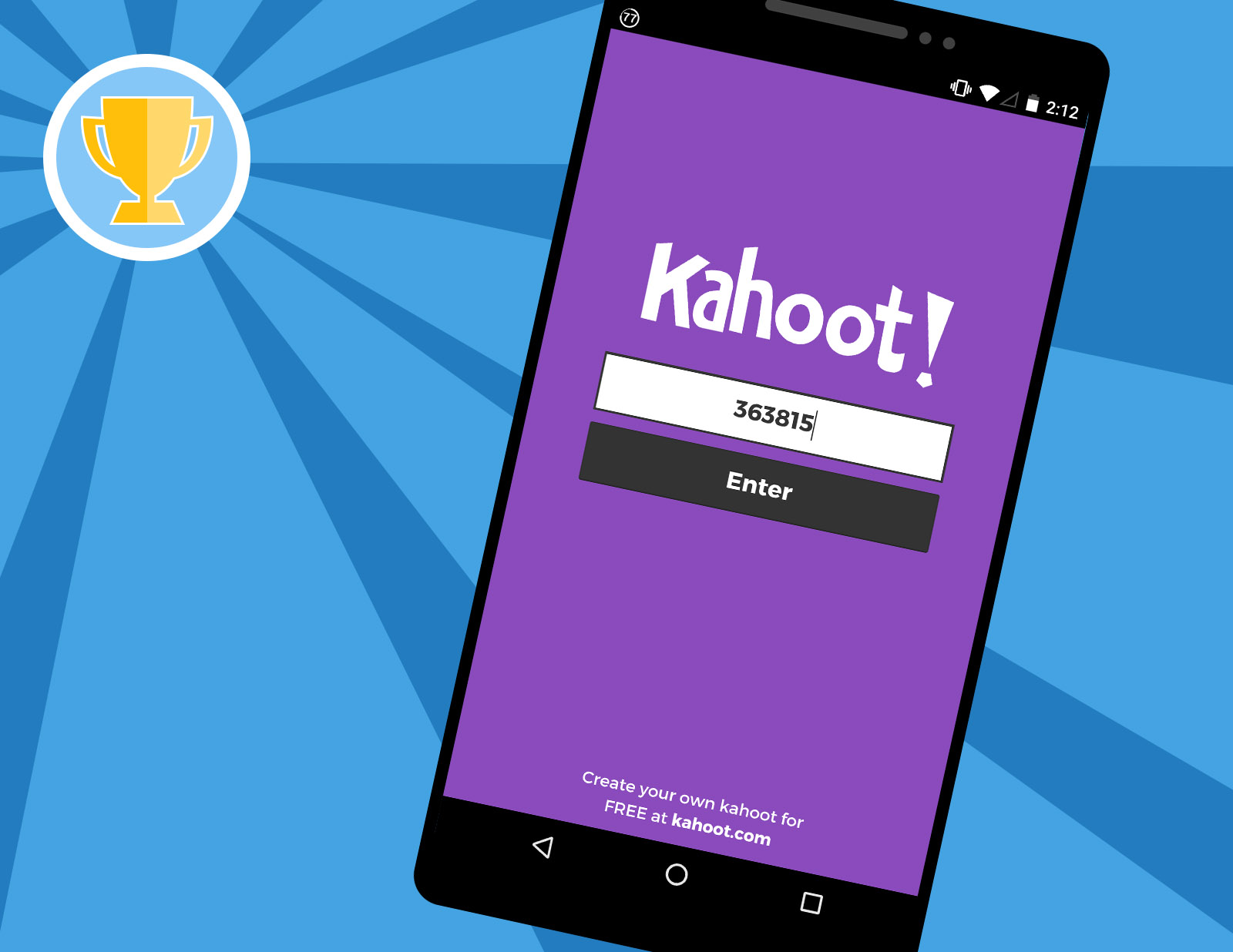

How To Make A Kahoot Game Pin
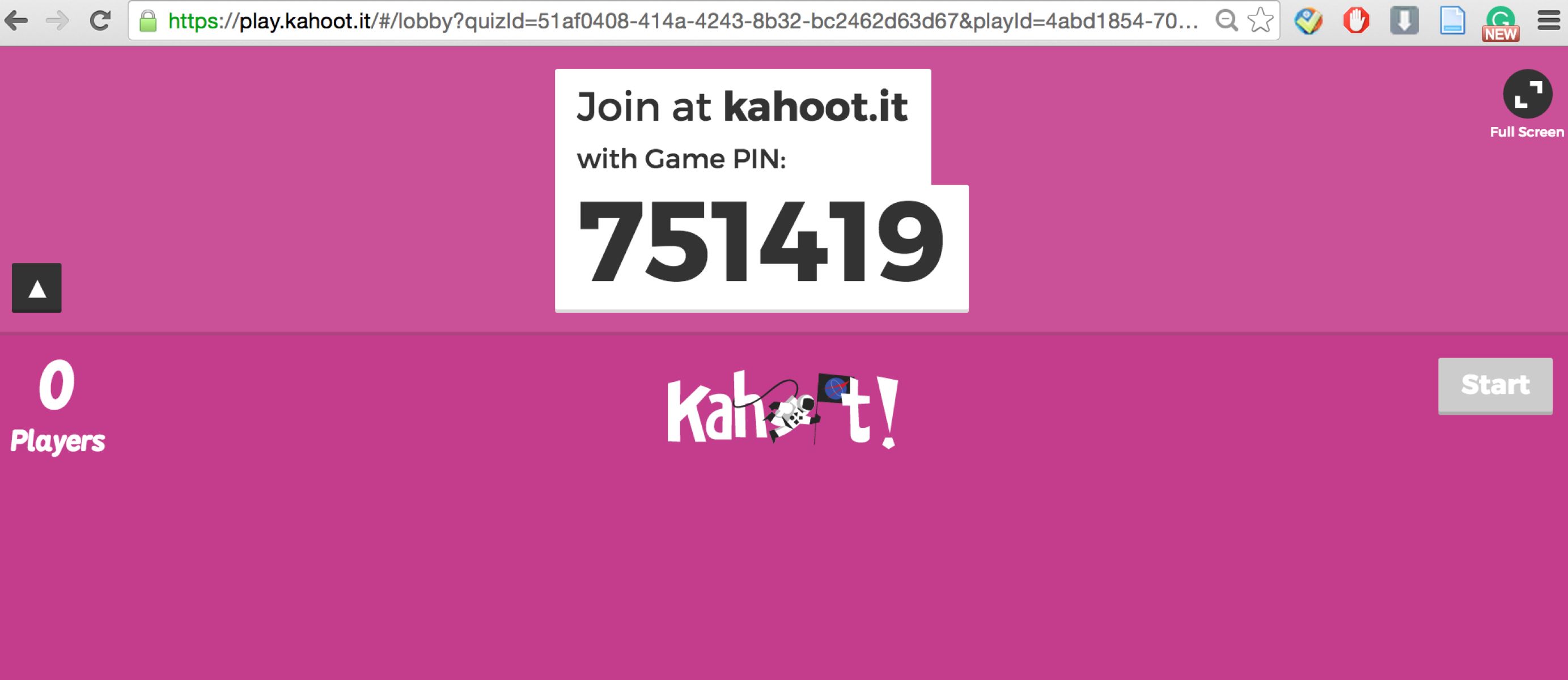
How To Get Kahoot Quiz Id

How To Play Solo Kahoot
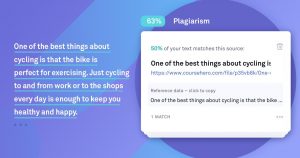
Is the Grammarly Plagiarism Checker Good? (A Review)

Scholastic E-wallet: How Does It Work?
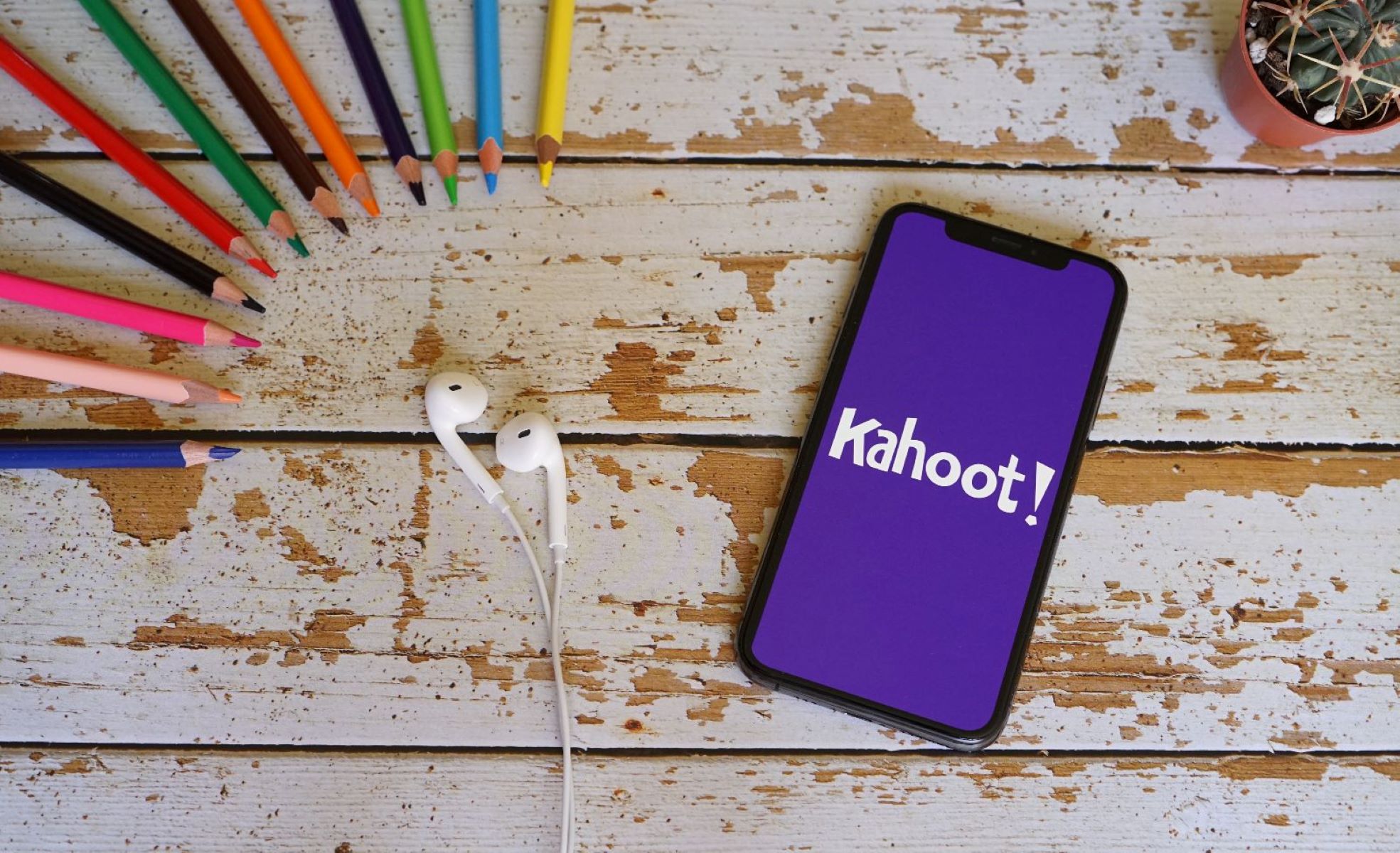
How To Start A Kahoot

AI in Education: Definition, Examples, Benefits and Future

CodaKid Review: Coding Made Easy For Kids
Recent stories.

How to Find the Best Midjourney Alternative in 2024: A Guide to AI Anime Generators

How to Know When it’s the Right Time to Buy Bitcoin

How to Sell Counter-Strike 2 Skins Instantly? A Comprehensive Guide

10 Proven Ways For Online Gamers To Avoid Cyber Attacks And Scams

- Privacy Overview
- Strictly Necessary Cookies
This website uses cookies so that we can provide you with the best user experience possible. Cookie information is stored in your browser and performs functions such as recognising you when you return to our website and helping our team to understand which sections of the website you find most interesting and useful.
Strictly Necessary Cookie should be enabled at all times so that we can save your preferences for cookie settings.
If you disable this cookie, we will not be able to save your preferences. This means that every time you visit this website you will need to enable or disable cookies again.
You are using an outdated browser. Please upgrade your browser to improve your experience.

How to Write an Email to a Teacher: The Ultimate Guide [+ Expert Tips and Templates]
How to write an email to a teacher:.
- Ensure you have a good reason for emailing.
- Use their school email account.
- Choose the right time to email a teacher.
- Craft a detailed subject line.
- Greet a teacher respectively.
- Be concise and clear
- Format your email for better readability
- Be polite and show gratitude
- Label any attached files properly
- End an email with your full name, class, and institution

In the post-COVID world of distance learning and online classes, emailing teachers is a sign of good manners, a channel for submitting essays and other assignments , and a chance to resolve any educational issues officially.
This article is your ultimate guide on how to write an email to a teacher. Try to remember and follow the tips mentioned here, and you won’t have to blush for your writing mistakes and low manners anymore.
Table of Contents:
- Your reasons for emailing a teacher
- Best time to email a teacher
- Subject lines
- Email structure and format
- Your tone of voice
Attachments
- How to end an email to a teacher
- Practical tips on how to email a professor
- Don’ts of how to email a teacher
- How to write an email to a teacher: templates
When It’s OK and Not OK to Email a Teacher
Emailing teachers is a formal procedure, so you shouldn’t burden them with dozens of messages every time you have a common question about a paper’s due date or general information about the course. Before you decide to email a professor, check the following information sources:
- the course syllabus
- the FAQ section of your teacher’s online discussion board (if they have any)
- the assignment description
The big chances are that you’ll find answers to your question there and won’t need to email a teacher. Teachers deal with many students and get dozens of emails daily, so why bother them with issues you can solve yourself?
And yet, there are some good-enough reasons when an email is a must. What are they?
Your Reasons for Emailing a Teacher
Jessica Robinson, Educator and Content Creator for The Speaking Polymath , suggest a deciding factor that can help students understand whether they should send an email to a teacher or not:
“If a teacher gets involved with students for assignments and homework only, it’s best to write an email on nothing but work. But in the case of more personal relationships and a teacher’s openness, it’s OK to write emails related to emotional problems as well. Bullying or any other insecurities at school can be a reason to address a teacher and ask for help.”
Good-enough reasons for emailing teachers :
- Inform about your illness or any other emergency
- Say that you’ll be absent in class and why
- Ask for an appointment to see a teacher during the office hours
- Submit completed assignments
- Thank a teacher for a meeting, guidelines, or any other help
- Apologize for wrong behavior in class
When is it not OK to write an email to a teacher?
Zach VanderGraaff, Music Teacher managing DynamicMusicRoom.com , shares his insights:
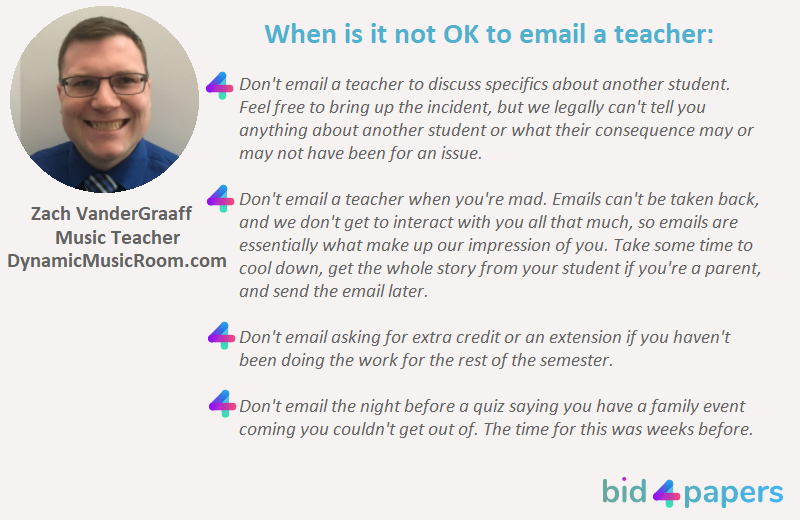
Rachel Coleman, Independent Education Consultant at CollegeEssayEditor.com , adds:
“Every teacher will set different standards for their relationship with their students. Some are more formal; others are more informal. The rule is to let the teacher define the boundaries and abide by them. If your teacher gives out her cell phone at the beginning of the year and says, “Text me if you need help on your assignments,” then you can assume texting is OK. If a teacher says, “Please only email me with the following questions: confusion about a homework assignment or grade, needing to miss class, requests for a letter of recommendation,” then it’s crucial to stay within the parameters of this instruction. But never assume! When in doubt, ask!”
Best Time to Email a Teacher
Zach also admits that emailing any time is OK, as long as you understand a teacher has boundaries too and can’t respond right away:
“ During the day, we have some time to send quick, short emails, but for the most part, we’re too busy teaching to respond with emails that require an in-depth answer. Want to increase the chances of getting a quicker turnaround? Then stick to the morning before school or toward the end of the afternoon. Most teachers do some emailing when they first get there and at the end of the day.”
Surveys confirm:
Teachers are more likely to open emails in the morning, between 7 am and 11 am , and then in the late afternoon, between 3 pm and 5 pm , when students have left school. So if you want to get a reply asap, organize your sending time accordingly.
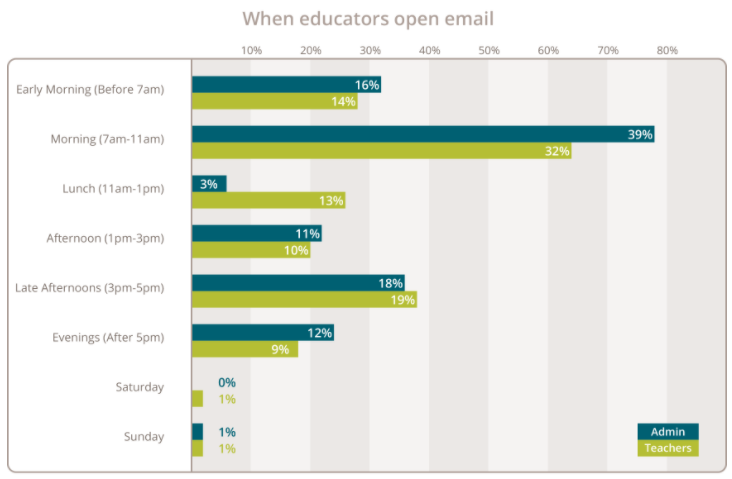
Source: Agile Education Marketing
Please avoid emailing teachers on weekends or holidays. Plus, it’s wrong to spam your teacher’s inbox when they don’t reply after hours.
Remember that teachers don’t spend all of their time at school. It’s best not to email them outside of their working hours. When you respect their personal life, they’ll be glad to help you as much as possible. For time-sensitive questions, don’t send emails less than 24 hours before you need a reply.
So, here’s a recap:
- Try not to email a teacher on weekends and holidays.
- Send your email during a teacher’s working hours.
- Don’t expect an immediate response: give them 1-3 days for a reply.
- Avoid spamming a teacher’s inbox every second hour; respect their time.
- Keep timing in mind when emailing on time-sensitive issues.
How to Start an Email to a Teacher
Two issues to consider here are your email’s subject line and the way you greet a teacher. It’s the first thing they see besides your name, so it’s critical to follow a few rules.
Subject Lines
The #1 rule: Make your email subject line as clear as possible.
Teachers have dozens of students and receive dozens of emails. The detailed subject line will help them understand who you are, what you want, and how time-urgent your message is.
No-no subject line examples:
- Homework question
- Assignment query
- Answer asap, please
- I’ll be absent tomorrow
Strong subject line examples:
- CHEM 112: Question about a lab on Monday
- Class meeting on Tuesday: 9:30 am
- Citation page for coursework: APA or MLA to use?
- Class 23: Confirming thesis for the assigned paper
They communicate the point to a teacher and help distinguish your email from colleagues, administrators, and other students. Plus, these subject lines are short and clear: They make a teacher understand the topic and urgency of your message.
Rebecca Rogers, School Teacher, author of this super cool TikTok account , confirms:
“I tell my students to make sure the subject line tells me what their email will be about because that will tell me how quickly I need to open that particular email. For example, if I have 20 emails to go through, I am more likely to open one with some urgency in the subject line first because I assume it needs my immediate attention. PLEASE DO NOT TYPE YOUR ENTIRE MESSAGE IN THE SUBJECT LINE! PLEASE! I AM BEGGING YOU.”
Her colleague Jessica Robinson, Educator and Content Creator for The Speaking Polymath , suggests students include their names in email subject lines:
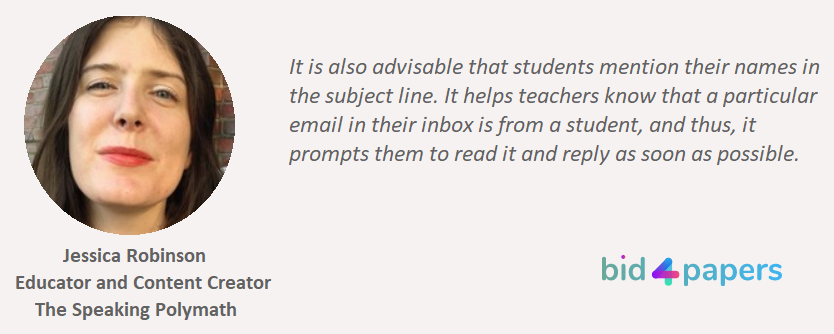
Other indicators such as the title of your class or the date of upcoming meeting can be helpful too. Consider examples like these:
- John Doe, class 42 – Question about research paper
- Tom Smith – Query regarding assignment on Geometry
- Biology 201: On the submission for Lab 3
- Lisa Martin: On upcoming meeting on Wednesday, 11 am
So, here goes a recap :
When emailing teachers, make your subject line short (less than ten words) and clear . Be as specific as possible: A teacher should understand at once who’s emailing and what’s the concern. Include your name and class to help a teacher identify you among dozens of other students.
The general rule here: Be polite and formal.
- Start with “Dear Dr./Mr./Mrs./Ms. Last Name” if you never met a teacher before or it’s the way you refer to them in class.
- Feel free to start with “Hello” or “Good morning/afternoon,” but make sure to personalize your greeting with names.
- Double-check the spelling of a teacher’s name. If in doubt, consider a school website, a faculty directory, or a syllabus to make sure you address a teacher correctly.
- Don’t be over casual, avoid greetings like “Hey” or “What’s up,” and try not to call a teacher by their first name unless it’s how you refer to them in lessons.
Rebecca nails it:

Long story short, consider your relationship with a teacher and the expectations of your institution. Refer to educators in the same way you refer to them in lessons. When emailing a teacher from different schools or colleges, please do your best to address them formally.
How to Write an Email Body
When emailing a teacher, some students forget about structuring the email body right. When sending a complete essay or any other assignment, it’s especially true: Students attach a file and click Send without adding any text to the email body.
It’s wrong!
Please always include a message in your email. Not only does it help a teacher understand the context of your message, but it’s also a sign of your good manners and respect.
Here’s how to write an email to a teacher, its body in particular.
Email Structure and Format
Remember that teachers are busy, so make the email body as short and straightforward as possible :
The ideal variant would be to keep it to five sentences or fewer. If that’s impossible, make sure to use short paragraphs and bullet points — therefore, your email will be quicker to scan. Yet, try to be concise and keep the email body fewer than 150 words. If you can’t express your message in 100-150 words, then maybe it would be better to email a teacher about a meeting in person.
Your email to a teacher is not a narrative or personal essay , so please avoid a flair of creativity. Stay concise and formal. Keep a single idea to one paragraph, and break them up for better readability. As Will Peach, medical school student and education blogger behind WillPeachMD.com , says:
“Don’t make your email an unsightly block of text (trust me, no teacher enjoys deciphering these).”
Speaking of formatting your email, please use standard fonts and text colors. Bold, italic, or underlined texts are OK if they help you convey a message or highlight crucial information (data, time, etc.), but say no to flashy fonts (those too large or too stylish) and rainbow text colors. Have mercy upon a teacher’s eyes!
That’s what Janice Wald, Teacher and Blogging Coach behind Mostly Blogging , recommends writing in email bodies:
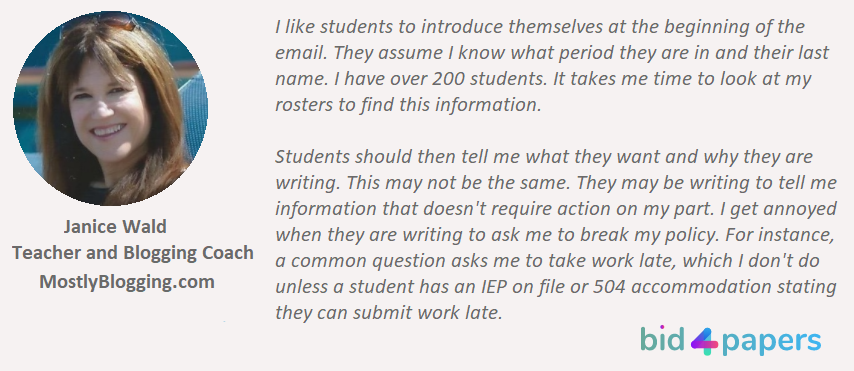
Here goes an example of how to email a teacher:
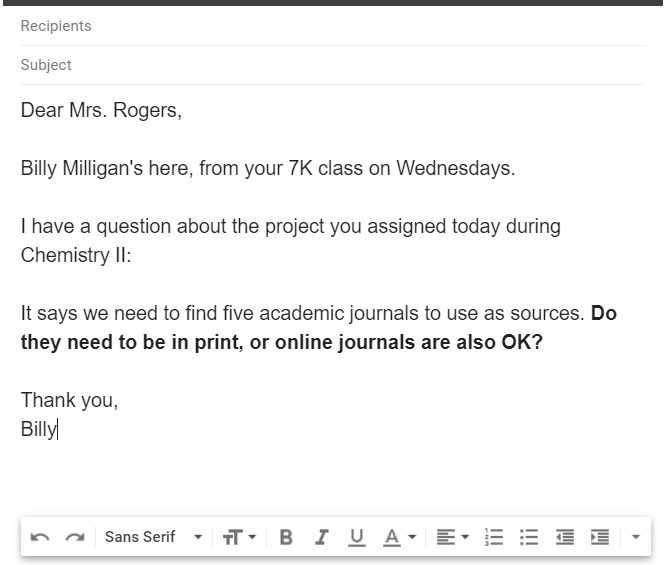
Your Tone of Voice
Being straightforward in emails doesn’t mean being sniveling or extra apologetic. When emailing a teacher, please keep your tone respectful .
- Avoid complaints about how much you dislike an assignment or how unfair a deadline is.
- No smileys or emojis — it’s OK to keep an email controversial, but it needs to be up-to-point.
- Avoid super long explanations, cliché statements like “I hope my email finds you well,” and saying how you’re sorry about disturbing a teacher. Be direct to the point.
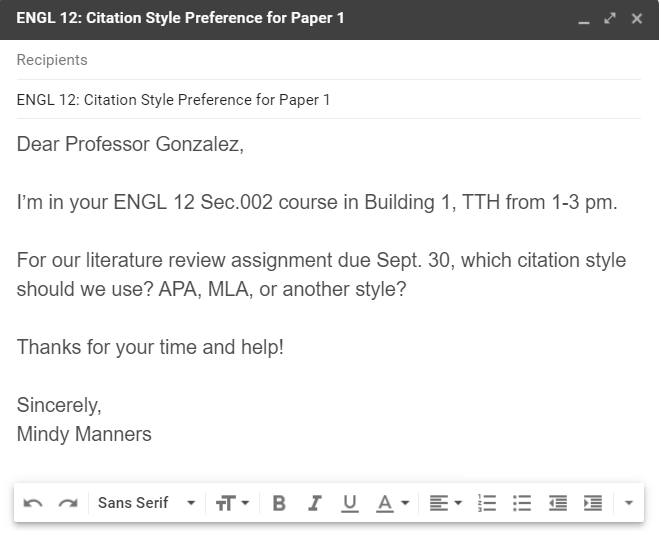
Here’s a practical tip:
Write a draft of your email in Microsoft Word or any other word processing software, not in the email program (Gmail, Outlook, or whatever you use). It will allow you to avoid grammar and spelling mistakes , as well as accidentally hitting Send before you’ve finished and proofread your email.
Emails to teachers often involve sending different attachments (complete assignments, tests, applications, etc.). If that’s your case, please follow a few rules:
- Do not attach files with no explanations. In the email body, provide specific details about what you send and why. (Example: “As you requested, I attach my critical essay here because I’ll be absent in class next Monday.” )
- Make sure to name your attached files appropriately. Include your name, class, the name of your assignment, and its number (or due date) if possible.
How to End an Email to a Teacher
Some students believe they don’t need to close an email because their names are evident in their email addresses. However, it’s a writing etiquette and your chance to add a personal touch to your formal email and show respect most teachers appreciate.
So, close your emails to teachers with courtesy.
First, sum your email up in one final sentence to spark a faster response. Consider variants like:
- Thanks in advance for your reply.
- I’ll look forward to your reply regarding my thesis statement .
- I will wait for your response before sending the complete test.
Second, remember to show gratitude and thank your teacher even before they respond. Phrases like “Thank you for your time” or “Thank you a lot for your help” positively influence how a teacher digests your information and regards you as a student.
And third, try to use formal closing lines. “All the best,” “Sincerely,” “Best regards,” or “Best” followed by your full name are great options to consider. Please avoid closings like “Cheers,” “Thanks,” or “See you tomorrow:” They are too casual for these reasons.
Schoolteacher Rebecca Rogers suggests:

Practical Tips on How to Email a Professor
Now that you know how to write an email to a teacher, here goes a quick recap:

You can also try to improve your email and teachers’ expectations even more with the following practical tips:
- Email a teacher only if you can’t find the necessary information in your class syllabus, school website, etc. Check all the options first; maybe you don’t need to write that email at all.
- Use a teacher’s school email address. It’s more professional, allowing them to keep all the correspondence with students in one place.
- Keep your email short and up-to-point.
- Remember about a proper greeting and closing.
- Draft your emails in a word document to avoid accidental sending. When finished and ready, copy-paste your message to the email program.
- Proofread and edit your email if necessary. Make sure to avoid spelling, grammar, and punctuation mistakes.
- Check the tone of your email. Stay formal.
- For complicated questions you can’t format into a 100-word email, it’s better to ask a teacher for an in-person meeting during their office hours.
Eric Kim, Co-Founder at LA Tutors , sums it up:
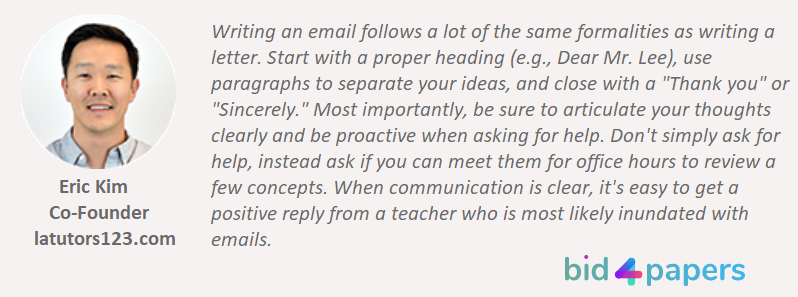
Don’ts of How to Email a Teacher
- Don’t email with questions you can ask in a class tomorrow. Respect a teacher’s time and privacy.
- Avoid colloquial or disrespecting language, common jokes, and personal topics.
- Don’t email a teacher with super time-sensitive questions. It may take them 1-3 days to reply, so keep timing in mind.
- Avoid slang, jargon, abbreviations, and emojis.
- Try to avoid contradictions in your email.
- Don’t write emails in CAPS.
- Say no to stylish fonts, super large or small font size, and bright text colors.
Faisal Nasim, Director of Exam Papers Plus , adds:
“The ONLY time you should email your teacher is if they have given you a school email account. If you’ve found a personal email address for them by some other means, do NOT email that account.”
- Don’t email to complain about other students or ask for extra credit.
- Avoid writing when you are sad or mad, and don’t use multiple exclamation marks.
- Don’t use textual language in emails.
- Never email teachers for purposes other than school-related. Avoid personal topics.
How to Write an Email to a Teacher: Templates
Below are a few templates (samples) you can use for writing emails to teachers. But before sending, make sure to customize and personalize them accordingly.
When asking a question:

When asking for a recommendation:
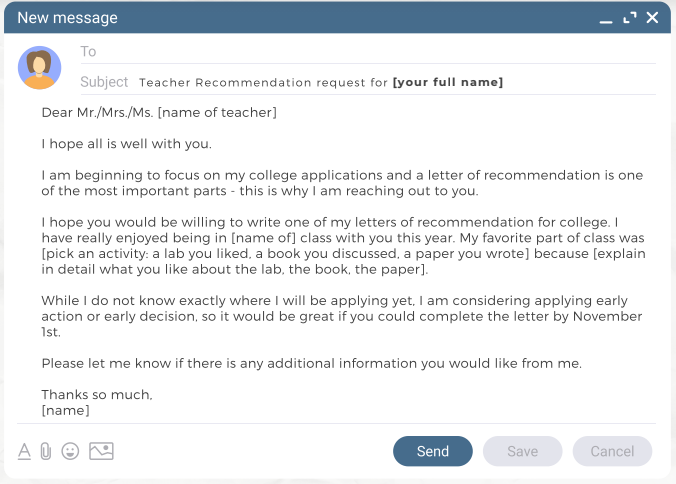
P.S. This template comes from Kate Sonnenberg, Tutor at KS College Success . Thanks for sharing, Kate!
If you need to ask for an appointment:

When you need to inform about your absence in class :

Following up with a teacher who hasn’t respond to your email yet:

Any questions or concerns left on how to write an email to a teacher? Feel free to ask our team for professional writing or editing help !
Related posts
- How to Write a Problem Statement for a Research Paper
- Tips on Term Paper Writing
- Footnotes: A Step-by-Step Guide with Word Instructions
Our Writing Guides
Trending Post : 12 Powerful Discussion Strategies to Engage Students
Email Etiquette: Teaching Students How to Email a Teacher
Email etiquette can be one of the most beneficial writing lessons of the school year. Students make great gains in a short amount of time. Consider…
From: [email protected]
To: [email protected]
Subject: HOMEWORK GRADE!
Mrs. Hart,
Why didn’t you put in my assignment yet? I turned it in after school today, and my dad is jonesing me about it. I’m going to be grounded all weekend if you don’t put it in asap. I hope you didn’t lose it.
[Insert sigh of frustration.] Emails like these are all too common at the secondary level. I used to get upset after reading one. I’d think, The nerve! How disrespectful. Who does this kid think he or she is? Stewing over it got me even more worked up.
One day, I had a heart-to-heart with a good student about an extremely rude email. During our conversation, she looked at me like a deer in headlights, and I could see she was completely unaware of the unintended tone of her message.
Later that day as I reflected on the bad email epidemic and this particular student’s response, it dawned on me. They’ve never been taught. And it’s true. Many students who sit in our classes after year have never been taught how to write an email to a superior (boss, teacher, or anyone else who would be addressed in a high-register tone).
So. I started teaching email etiquette. And guess what? Lo and behold…it worked (mostly). While teenagers are still learning how to master tone (we have to give them a little leeway and use teachable moments when they arise), we can’t expect teens to be able to intelligently and respectfully communicate with adults in a language that is somewhat foreign to them if we don’t give them the tools to do so.
WHY TEACH EMAIL ETIQUETTE
First and foremost, no one appreciates receiving a rude email.
However, it’s also a form of communication that is highly valued in our society, both in personal and professional realms. We are living in a digital age where online communication skills are essential to success. Did you know that 99% of people check their email daily, and over half of those people check it before social media? Most of these individuals refresh their inboxes multiple times a day. No doubt, it’s a dominant way humans speak to one another.
In a school environment, direct instruction about email etiquette provides background students will need to discuss author’s tone and writer’s voice throughout the year. Plus, it coincides SO WELL with any digital citizenship and career readiness lesson. Are students aware that as soon as they press “send,” that email is part of their permanent digital footprint?
Beyond high school, secondary teachers need to empower students to succeed in college and the workplace. One day, they won’t have anyone to teach them how to write an email that conveys their message respectfully. They’ll just need to know how to do it as a professional in the workplace! We need to seize the opportunity while we can and set the stage for them to be successful in life.
Then, there’s relevance. Email etiquette is a skill in which students should find value. Often, we hear, Why do we even have to learn this? When are we ever going to use this in life? With this topic, students should see the direct connection to their lives and understand how much it will benefit them.
WHEN TO TEACH EMAIL ETIQUETTE
While email etiquette could be addressed at any point during the year, I often use it as my back-to-school writing unit . In doing so, I experience fewer unpleasant communications during the remainder of the year, and students benefit by knowing how to confidently email their teachers all year long. Not only will reading their communication make your life easier, but also your colleagues will thank you for making their lives easier.
In middle and high school, students begin to email their teachers more frequently, so these are the ages where this type of lesson would be crucial. Because email genre is one that transcends subjects, it lends itself well to cross-curricular study opportunities.
If your students communicate mostly via a learning management system chat function, these same guidelines apply!
HOW TO EMAIL A TEACHER: 4 BEST PRACTICES
1. establish criteria..
How is a student to know what is acceptable and what is not without a list of guidelines? I begin my email etiquette unit with practical tips that teenagers can apply to their own writing in order to sound more professional and respectful. At first, we use the tips I introduce to them, but soon enough, students are adding onto that list with some ideas of their own. And I love it! From there, we move on to evaluating texts based on those criteria.
2. Use engaging examples.
Most students have probably broken one or two etiquette rules in the past. The last thing I want to do when covering a subject like impolite emails is resort to shaming, so I keep it light. I use humorous (and often over-the-top) #EmailFail examples mixed with more down-to-earth and realistic ones. As a class, in small groups, and individually, we read, analyze, evaluate, discuss, and revise the model texts. Supplementing with video clips is an additional way to differentiate and make the content more interesting to twenty-first century learners.
3. Provide an authentic audience.
It’s difficult for students to truly take a writing assignment seriously if they don’t have an authentic audience. A best practice with writing is to have the students actually send the email to the recipient. In doing so, I’d strongly encourage you to either make yourself the recipient of an email in response to a fabricated scenario or to read through students’ drafts before allowing them to press “send” to another teacher (for obvious reasons).
In the past, I’ve asked students to think of a class they have strong feelings about in the moment. (We need to harness real emotions in order to help students understand how to channel and word them respectfully.) Maybe they are angry because the teacher just assigned a large project. Perhaps they are worried because it’s a speech course, and they are deathly afraid of public speaking. Or it could be that they just hate math…have always struggled with it…and are concerned about being pushed too far out of their comfort zone. I then ask them to draft an email to the instructor of that course, which leads us to best practice #4.
4. Give immediate feedback.
The easiest and quickest way for students to learn what’s acceptable and what’s not is if I go over their draft with them right then and there. I read it out loud so we can both hear it as the sender would interpret it. This way, their intended tone is not apparent, and I point out areas for improvement. For example, in her email, my student Jacky might have written something like:
Dear Mr. Stine,
I was wondering if you’d be willing to move the science test back another week? I have been studying on my own, but the study guide you provided is not very helpful, and I don’t feel like we’ve covered the information well enough in class. Some of my friends have also expressed similar concerns, and we all think an extension of the test date is in order.

While Jacky’s email might follow a lot of the obvious, more minor guidelines for email etiquette, I would conference with her about how she could word her concerns in a tone that would win the audience over to her side rather than alienating the instructor by putting him on the defensive.
The number one comment I find myself repeating to students as I conference is this: Would you say this to their face? No? Then we need to word it differently in writing. Like text messaging or commenting on social media, it’s easy to make hurtful and even mean remarks when you’re separated from the audience by a digital wall.
Year after year, parents report to me that immediate feedback through conferencing is the number one factor in helping their children grow as writers. It’s in this safe place that we can be honest, we can provide real-time feedback, and students can make improvements to their writing.
EMAIL WRITING AS A PRE-TEST
No one wants to start the year with a stack of papers to grade. Actually, people generally don’t like stacks of paper at any time of the year. Yet, in order for students to really understand email etiquette, they need practice and repetition. So. How do we grade it without overwhelming ourselves?
We can start by asking a simple question: What’s the purpose of this unit? In short, the goal is to help students communicate more politely in writing. What’s the best way to teach them? In class – through practice and conferencing. Therefore, most of the “grading” takes place through discussion.
Teaching students about email etiquette doesn’t have to add to equate to a mountain’s worth of grading. Plus, by allowing students a free space to experiment, be vulnerable, and receive feedback that doesn’t hurt their grade, an invaluable risk-taking platform develops; consequently, it creates a writing culture in which students feel confident and free to toy with their skills.
Many teachers begin the year with pre-tests, and I have as well. Formal writing pre-tests have value, but I find them more appropriate in small-group settings, for intervention, or with tutoring. Besides, trying to grade a stack of essays (even in the form of emails) at the beginning of the year is overwhelming. It’s not fun to start the year feeling behind.
Since the goal of pre-tests is to help teachers gear their writing instruction, teachers can use email etiquette lessons to inform their future writing instruction. As you read students’ email drafts and conference with them, you can keep a list of common errors you notice and use this information, which is gained in an authentic way, to decide where you want to begin your formal writing lessons.
FINAL THOUGHTS…
Remember poor late-work Vinny? What if his email had sounded like this?
Dear Mrs. Hart,
I am so sorry for not turning in my “Scarlet Ibis” reading response on time. It’s my responsibility. I submitted it at the end of the day today, but I didn’t see you in your classroom. I just want to make sure you received it. Can you verify? Thanks so much in advance for your time in responding, and I apologize for the inconvenience.
Do your students have any experience with writing formal emails to teachers, bosses, or other superiors? Do you receive emails from students which could be more professional? Will your students be applying for a job one day? Students of all subject areas and grade levels can benefit from some engaging #EmailFail and Email Etiquette 101 lessons . Let’s help ourselves by helping our students hone real-world writing skills that will give them a competitive edge. You might be surprised how many of your students will thank you in return.
- Teaching Students to Avoid Plagiarism
- Ways to End the Year Well
- Playlist of My Year – An Engaging Writing Activity
RELATED RESOURCE SPOTLIGHT
You can view the materials I use in my classroom here . Use it to complement your own email etiquette materials or as a complete unit.
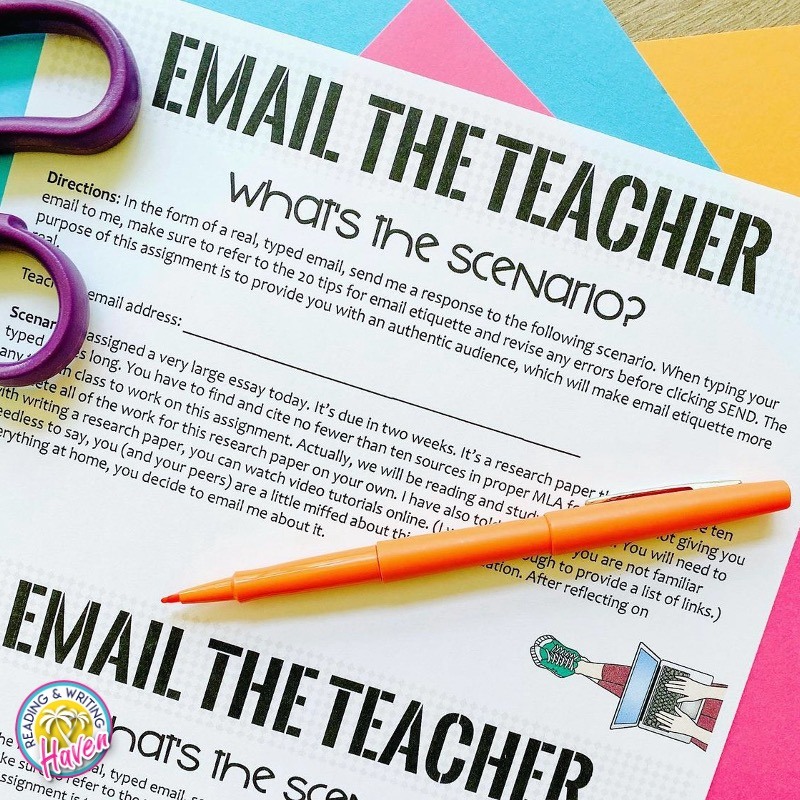
If you need a FREE writing survey to gather information about your students’ interests, you can find the one I like to use here .
Happy teaching!
Get the latest in your inbox!

The Black and White

How to write an email to your teacher
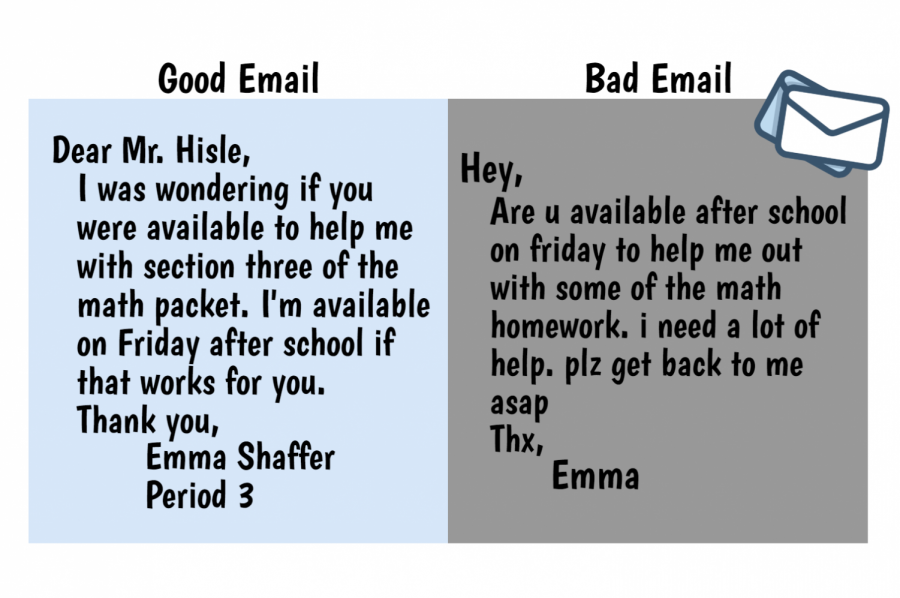
Graphic by Alex Silber.
By Emma Shaffer June 2, 2018
The mouse cursor hovers over the send button as a sophomore girl rereads her email: “Can u help me at lunch tmrrw?” She hits send and waits for a response. Later that day, while scrolling through his inbox, her teacher rolls his eyes at yet another unprofessional, one sentence email.
A well-worded email could substantially increase your chances of getting that grade bump, extension or opportunity for make-up work. One riddled with slang and abbreviations, however, could do the opposite.
Teachers often receive emails that are sloppily written or missing important information, which hurts their ability or willingness to help the student, history teacher Katherine Young said. Students: keep your audience in mind.
After talking to five Whitman teachers, The Black & White compiled these tips to help students write better, more effective emails to teachers.
Tip #1: Be respectful
The most important thing to remember in email writing is to be professional and respectful. Teachers are taking time out of their day to read and answer your emails, so thank them for extending their duties outside of the classroom. Ask rather than demand. Always begin your email by greeting your teacher. Then, write a brief comment, such as “hope your day is going well.” By doing this, you create a stronger interaction between you and your teacher, just as you would in person.
Emails that simply jump into what a student needs are very unprofessional, Young said. Just asking a straightforward question isn’t enough, especially if you’re asking a favor.
Tip #2: Always include your name
Including your name and class period in the email helps the teacher identify who you are, making it easier to respond.
Many student emails don’t formally address the teacher at the beginning or use a signature at the end, making it hard to tell who the email is from, especially when students use email addresses that don’t indicate the sender’s name.
Tip #3: Drop the text lingo
Ensure your message comes across clearly by using proper grammar and spelling. You may text your friend in incomplete sentences or shorthand, but that style of writing has no business going to teachers.
Never use slang or text lingo while writing an email. For example, spell out the word “you” instead of “u” and say “thank you” instead of “thx.” By doing this, you demonstrate respect for your teacher.
When a student isn’t clear in their email, it makes it difficult for teacher to understand what the student needs and how to help them, said engineering teacher Rachel Stender.
Tip #4: Know when to talk to your teacher in person
While sending an email to a teacher is sometimes more practical due to time constraints, many teachers do prefer an in person meeting. More serious conversations should always be discussed in person, math teacher Ralph Hisle said. However, an email can still be helpful for setting up these conversations.
Some teachers don’t appreciate when students ask for big favors, such as a grade bump, over email. When asking a teacher to bump your grade—which they’re under no obligation to do— talk to them politely in person, Stender said.
Todd Michaels, an English teacher, is known for his strict policy against grade bump emails.
“There’s a kind of email that I find insulting, which is a student thinks they deserve a certain grade, and it doesn’t matter what I think as the teacher,” Michaels said.
Tip #5: Check your inbox for a response
After you’ve emailed your teacher, remember to check your inbox frequently. If a teacher takes the time to email you back, check, read, and follow up with them.
Teachers may send casual email responses which could make you think formalities are unnecessary, but it can never hurt to be respectful in your writing.
“People can pass judgment on you based on how you express yourself in writing,” Young said. “I think it’s just really a good life skill to learn.”

By Kavi Varma
April 16, 2024
The boys’ lacrosse team (6–1) destroyed the Poolesville Falcons (4–2) 18–3 Wednesday...

By Leo Pelmoter
Whitman Girls Softball (6–2) defeated Seneca Valley (3–5) 9–7 on Monday, April 15th...

By Kavya Rajani
The girls’ lacrosse team (7–0) defeated the Poolesville Falcons (3–3) 19–4 on...

By Katelyn Leonard
A young woman glares in frustration at the mountain of clothes tossed haphazardly onto...

By Rishith Alimchandani
On April 11, Whitman administrators announced a new testing schedule that will be implemented...

The power of interior design in schools
The Student News Site of Walt Whitman High School
- 2018 Destinations
- About ‘The Black & White’
- Advertising
- Corrections
- Current Staff
- Destinations 2017
- Polls Archive
- Print Archive
- Scores and Schedules
- Sexual Abuse Survivors’ Resources
- Subscriptions
- Upload a Photo
- Volume 62, Issue 2
- Volume 62, Issue 4
- Volume 62: Print Issues
- Weekly Crossword – 3/22
Comments (29)
Cancel reply
Your email address will not be published. Required fields are marked *
BALLER • Aug 15, 2023 at 6:13 pm
baller !!!!!!!!
jackson stein • Oct 6, 2022 at 1:06 pm
wow really good!
arravs big toe • Oct 6, 2022 at 1:05 pm
ayo stop deleting my comments and give me mod
thispersondoesnotexist • Jan 31, 2024 at 10:14 pm
101001010001010100101010111100100110010101010101010
B word • Oct 6, 2022 at 1:02 pm
arravs big toe • Oct 6, 2022 at 12:59 pm
i am arravs ig toe
arravs big toe • Oct 6, 2022 at 1:02 pm
i need mod real quick
garfeild • Oct 6, 2022 at 12:56 pm
B word • Oct 6, 2022 at 12:49 pm
Aarav Bhatia • Oct 3, 2022 at 1:14 pm
Thanks this really helps!
Jake • Oct 3, 2022 at 1:10 pm
This is realy helpful thank you
joey • Sep 1, 2022 at 9:57 am
Alex • Aug 24, 2022 at 11:09 am
Hello Mr. Beam I would like some extra credit. -Alex
Natalyah • Aug 19, 2021 at 12:39 pm
Good morning Mr.Gillizer
I hope you are having a wonderful day
Davin Morris • Aug 16, 2021 at 8:42 am
I still need to learn Spanish I am okay now but i need to improve
yara gallegos • Nov 10, 2020 at 10:27 am
I think that I still need to learn English and I think that little by little I am going to catch it and that in some classes it is very difficult for me …
Harrison Michael Miller • Oct 23, 2020 at 9:00 am
My favorite knife cut is chop.
Harrison Michael Miller • Oct 23, 2020 at 8:47 am
The mail that I need to do is perfect
jennifer • Oct 7, 2020 at 10:54 am
dear mrs beer.
i really enjoy the self portrait that you assigned for us all,also i really enjoy when you let us listen to music when were working,
from:rayvin
kenya • Sep 14, 2020 at 10:00 am
This was very helpful.,this kinda makes me wanna use big words
kenya • Sep 14, 2020 at 9:59 am
This was very helpful.
Janelle Blanco • Aug 28, 2020 at 4:21 pm
Hello Ms. Salome
I want to tell you some things about me.
My favorite color is Pink
My favorite food is spaghetti
In my free time I like to paint and watch Tiktoks
I hope you enjoyed reading some stuff about me
Sincerely, Janelle Blanco.
hot guy • Oct 6, 2022 at 1:04 pm
lemme get that number girllll
Genessis Orozco • Aug 27, 2020 at 2:17 pm
These tips are really helpful for me thank you.
andrew • Aug 19, 2020 at 4:36 pm
black and white are still people
Leo Canchola • Apr 27, 2020 at 2:51 pm
Getting this homework done
Graham Soofer • Jun 3, 2018 at 11:11 pm
I think this was very informative and helpful. I do believe that this entire article was plagiarized and this student should be expelled. An awful showing of academics. Shame on the teachers.
B word • Oct 3, 2022 at 1:13 pm
big man • Oct 6, 2022 at 1:03 pm
How To Write A Clear, Polite Email To A Teacher — With Examples
Yes, even when you’re big mad.

Why is it that approaching our kids' teachers can spike our anxiety? Maybe it's past trauma from our grade school years. Perhaps it's the fact that emotions run high when it comes to our kids, so we know a tense conversation could be the outcome . Whatever the reason, it's something that we parents will definitely have to overcome since, at some point in each child's K-12 years , the need to communicate with their teachers will inevitably come up. Fortunately, it will probably be as easy as shooting over an email (especially in this digital age). But that prospect isn't without worries, either. You might even be wondering how to write an email to a teacher in a way that is appropriate, respectful, and conveys the point you're trying to make.
Depending on the matter you're reaching out to discuss, it could either be a breeze or perhaps a little awkward. But isn't that a big chunk of parenthood — facing awkward situations caused by the little people in our lives? With the right approach, this doesn't have to be one of them. So, if you're curious about the proper protocol, stick around for a few examples.
Subject Line
Teachers get a slew of emails, so keeping it short but informative will help them differentiate between an important email and one that can wait. It can also help them identify which one of their students it concerns and what it pertains to.
Instead of:
" Homework question… "
" Question about Gabe's math homework due this week "
If you've never met your child's teacher before (which might be the case for many parents these days), play it safe and stick with something polite and formal. A good rule of thumb is to address teachers the same way your child would.
"Hey, Sarah!"
"Good morning, Ms. Brown!" (And use "Ms." if you're unsure of their marital status.)
Email Body and Format
Teachers are busy! Remember, they have an average of 24 students. Keeping your email clear and concise is just one way to show your respect for their time. If the matter requires a lengthier conversation, don't jump right into the meatier stuff in your initial email. Instead, give the teacher a clear understanding of what you need to discuss, ask them for their availability, and, if possible, express your flexibility in setting up a chat.
"Gabe is having problems with some of his classmates that, from what I understand, are due to an incident on the playground a few weeks ago. He says Megan excluded him from a basketball game, which made him really sad..."
"I'm concerned about Gabe's relationship with his fellow classmates, and I'd like to set up a brief chat with you so we can resolve the issue. Please let me know your availability for next week. I'm flexible."
Tone of Voice
Teaching isn't an easy job, and most teachers do it because they truly care about the education of children — including yours. Using a respectful tone when emailing your child's teacher is not just an option; it's simply the right thing to do. If a teacher has done or said something that you feel is inappropriate, remain respectful and take up the matter with the principal or other school official, if necessary.
"I don't appreciate that you've been sending home so much homework. It's really a lot to deal with, and it's overwhelming for my child!"
"Keeping up with the homework assignments has been a bit of a challenge for our family. Is it possible to make some adjustments?"
Attachments
Sometimes you may need to add an attachment to your email, like if your child is out sick and you need to submit their makeup classwork. Make sure your email mentions any attachments, and name each attachment appropriately. Also, remember that most email servers allow a maximum of 25 MB per attachment. Sending a link to a cloud drive is a great alternative to attachments.
Like the greeting, ending your email with a polite sign-off shows your respect and may even increase your chances of a quicker reply.
"Talk to you soon! – Gabe's mom"
"Thank you in advance for your time and reply! Sincerely, Melissa Smith (Gabe's mom)"
The next time you need to reach out to your child's teacher, you'll know exactly how to start and write an email that follows protocol and doesn't leave your index finger hovering over the send button in doubt.
Additional Tips for Emailing Teachers
Gone are the days of sending your kid to school with a note. Well, not completely, but email is instantaneous and way more efficient than using children as messengers. But these email interactions can sometimes be a little tricky and stressful. So, here are a few tips you can use when communicating with your child's teacher via email.
- Use your professional email address if you have one. Messages are more likely to get lost in your personal one.
- Before you add a link or attachment, ask yourself if it’s vital to the message. You don't want to clog the email with information the teacher may not need.
- In the email, push for a phone call or a face-to-face meeting. With kids, few issues can be resolved via email. It's best to get in front of the teacher if you can.
- As parents, we go to bat for our cubs no matter what, and you can still do that without hurting the relationship you have with your child's teacher. If you're especially teed off or emotional, take a beat and come back to writing the email a little later. You'll write a much clearer and concise email if you give yourself a little time.
*Keep in mind teachers don't blame parents for their child's actions. An educator's job includes juggling 10 to 20 children, each with their own personality and needs. It's important to remember to give teachers the benefit of the doubt. Teachers are part of the community used to raise a child, so try to see them first as team members instead of adversaries.
This article was originally published on March 18, 2022
Flow through your inbox
Flowrite turns your instructions into ready-to-send emails and messages across your browser.
.png)
For companies
Aug 8, 2022
How to email a professor with 22 different examples
Learn how to email your professor (and what to avoid doing) and check out 22 sample emails to help you get started.

Lawrie Jones
Table of contents
Is there anything more nerve-racking than sending an email to a professor?
Every student will need to send an email to a professor at some point, whether you're asking for an extension, explaining an absence, or a little extra help. But how do you write an email to a professor?
In this guide on how to email a professor, we break down the steps to writing better messages. You'll learn the structure of a good email to a professor (and what to avoid).
And if this is not enough to convince you that it's easier than you might think, we finish off by providing 22 sample emails to a professor!
If you want to impress your professor with perfect grammar, make sure to try Flowrite :
How to send an email to a professor
So, how do you write an email to a professor? Professors are professional people who will be used to traditional email etiquette. That's not to say that you can't introduce some individuality into your emails; it's just important to show respect.
You'll understand your relationship better than we do. You can be a little less formal if you feel it's appropriate.
Following the correct email etiquette is essential – and easy. In this article we break it down into steps to illustrate what we mean. We've also written about proper email etiquette on our blog before:
It's also important to keep emails short and to the point. Professors receive hundreds of messages daily and don't have time to delve too deeply to get the information they need. Say who you are, what you want, and why you're messaging upfront.
Should I send an email to a professor?
Classes can be busy, and a professor's time can be limited, so email is an ideal way to communicate with your Professor. Emails enable you to go into detail, create lists and spend time crafting a complex message.
If your question or comment is urgent or sensitive, consider whether it's better to book a meeting or pull them aside for a chat.
Only you can decide whether to email a professor.
How long should I wait for a reply?
Professors are people with busy lives and professional responsibilities, so you may need to wait for a reply. But how long should you wait for a response from your Professor?
There are no hard and fast rules on how long to wait for a reply, but the general rule is to give it two or three days before sending a follow-up. You can learn more in our guide on how to write a follow-up email.
Email format for messaging a professor
The email format for a professor should be familiar to anyone who understands the basics of messaging. Here's how it works:
• Subject line
• Body copy
• Signature
If you're unfamiliar with how to write a formal email, check out Flowrite blogs that delve deeper into what makes a great subject line, how to greet someone, appropriate sign-offs, and striking the right tone of voice.
Subject line for an email to professor
Your subject line should spell out exactly what your message is about. Why? Because professors get hundreds of emails daily, they'll need a reason to open and respond to yours.
We've provided some examples below.
How to greet a professor in an email
Professors should always be addressed using their titles. You can open an email in a few ways, such as:
• Dear Professor
• Hi Professor
Avoid casual openings, such as "hey" or "how are you doing?". Instead, always uses your Professor's title to show respect, even if you start an email with "Hi" or "Hello."
How to address professor in email
We've covered the importance of using a professor's title in an email, but there's more to it. When discussing how to address a professor in an email, we're talking about the tone of voice – and getting that right can be tricky.
You'll want to be personal, but being too familiar can cause problems. We've written before about how to hit the right tone, so start there. Our examples below show how we've put this into practice.
How to start an email to a professor
An excellent way to start your email is by stating who you are and explaining what your message is about. As we've established, professors receive hundreds of messages every day, so they'll skim-read your message. Unless you're clear with what you want, you could find it binned.
You can see 22 examples of how to address your emails and get to the point as soon as possible.
How to sign off an email to professor
There are several ways you can end an email you a professor. Traditionally, you'd use "your sincerely," but today, you can be a little less formal. Some safe email endings to a professor include:
• Kind regards
• Yours sincerely
Email to professor examples
So, we've explained the basics of emailing your Professor; now it's time to put it into practice with samples. Here are 22 email to professor examples that should cover any scenario. So, whether you're asking for advice, access to a class, or a little extra support, we've got a template for you.
22 sample emails to a professor
Here are 22 examples of how to email your Professor. These should cover a whole range of situations that you could find yourself in. As with all our templates, use them as inspiration, and be sure to adapt them to your specific situation.
Ready to get writing to your Professor? Then let's begin.
1. How to write an excuse email to professor example
2. how to email professor for extension example, 3. how to email professor asking for extra credit example, 4. how to email a professor about failing a class example, 5. how to send a follow-up email to a professor, 6. how to write a formal email to a professor example, 7. how to email a professor about getting into their class example, 8. how to email a professor about a grade example, 9/ how to introduce yourself in an email to a professor example, 10. how to ask professor to accept late assignment email example, 11. how to email a professor for a letter of recommendation example, 12. how to email professor about missing class example, 13. how to write a polite email to a professor example, 14. how to write a professional email to a professor example, 15. how to write a proper email to a professor example, 16. how to ask a question to a professor email example, 17. how to write a reminder email to professor example, 18. how to reply back to a professor's email example, 19. how to email a professor about research example, 20/ how to schedule an appointment with a professor email example, 21. how to email professor about being sick example, 22. how to write a thank you email to a professor example, closing words.
Writing emails to a professor can cause mild anxiety, but it doesn't need to be so. We hope that breaking down how to email a professor into steps and providing a massive number of samples will help.
It's essential to understand the principles of crafting professional emails, such as an email to a professor – now it's time to put it into practice.
Supercharge your communication with Flowrite
Write emails and messages faster across Google Chrome.
Explore Flowrite
.png)
Start using Flowrite today
Try it yourself
General template
Reply to: "
Received message
introduce flowrite short instruction to ready to send emails we finish email
Generate a reply
Generate an outreach
Share this article
Related articles

How to write a thank you email with 39 samples and template
Wondering how to say thank you? Our thank you email template and 30 thank you email examples will help you say thank you meaningfully.

How to ask for something in an email with 9 examples
Learn how to write request emails that get results with our in-depth guide. This article breaks down the process of writing request emails for information, documents, contact details, favors and more.

10 coolest new productivity tools of 2021
We went to find the best productivity tools so that you can skip the browsing and take them for a test drive.

We use cookies to analyze site performance and deliver a better experience for visitors.
%20(1).png)
Product updates
Read the latest →
%20(1).png)
About Flowrite
Get to know us →
Productivity

© 2023 Flowrite
- PRO Courses Guides New Tech Help Pro Expert Videos About wikiHow Pro Upgrade Sign In
- EDIT Edit this Article
- EXPLORE Tech Help Pro About Us Random Article Quizzes Request a New Article Community Dashboard This Or That Game Popular Categories Arts and Entertainment Artwork Books Movies Computers and Electronics Computers Phone Skills Technology Hacks Health Men's Health Mental Health Women's Health Relationships Dating Love Relationship Issues Hobbies and Crafts Crafts Drawing Games Education & Communication Communication Skills Personal Development Studying Personal Care and Style Fashion Hair Care Personal Hygiene Youth Personal Care School Stuff Dating All Categories Arts and Entertainment Finance and Business Home and Garden Relationship Quizzes Cars & Other Vehicles Food and Entertaining Personal Care and Style Sports and Fitness Computers and Electronics Health Pets and Animals Travel Education & Communication Hobbies and Crafts Philosophy and Religion Work World Family Life Holidays and Traditions Relationships Youth
- Browse Articles
- Learn Something New
- Quizzes Hot
- This Or That Game New
- Train Your Brain
- Explore More
- Support wikiHow
- About wikiHow
- Log in / Sign up
- Computers and Electronics
- Online Communications
- Writing Emails
The Best Practices for Emailing a Teacher About Being Absent
Last Updated: April 25, 2023 Fact Checked
Sample Emails
- What to Write
Email Etiquette & Tricks
This article was written by Ashley Pritchard, MA and by wikiHow staff writer, Aly Rusciano . Ashley Pritchard is an Academic and School Counselor at Delaware Valley Regional High School in Frenchtown, New Jersey. Ashley has over 3 years of high school, college, and career counseling experience. She has an MA in School Counseling with a specialization in Mental Health from Caldwell University and is certified as an Independent Education Consultant through the University of California, Irvine. There are 7 references cited in this article, which can be found at the bottom of the page. This article has been fact-checked, ensuring the accuracy of any cited facts and confirming the authority of its sources. This article has been viewed 425,948 times.
It happens! Sometimes you have to miss school. Whether you have a doctor’s appointment during math class or wake up sick with the flu, everyone misses class occasionally. But how can you let your teacher or professor know you’ll be out? A quick email can solve all of your worries and keep everyone updated. In this article, we’ll walk you through how to write an absence email to your instructor so you can stay in their good graces.
Things You Should Know
- State when and why you’ll miss class at the start of your email (and be honest about it).
- Express your apologies for being absent to show the instructor that missing class is the last thing you want to do.
- Ask your teacher or professor for any work you may miss so they know you put your studies first.
- Attach any homework or due assignments to your email to stay up-to-date with your coursework.
What to Put in Your Email

- “Out Sick 3/10”
- “Missing Class on Friday”
- “ENGL 101 - Absent due to family emergency”

- “Good morning, Mr. Dickson,”
- “Dear Professor Smith,”
- “Mrs. Evans,”

- “I wanted to let you know that I will not be in class today because of an unexpected family emergency.”
- “Unfortunately, I cannot attend your lecture on Friday because I have a doctor’s appointment.”
- “I am emailing you to inform you that I will not be in class on Monday, July 17th.”

- “I recognize that we have a paper due on Monday, so I’ll turn it in on Friday instead.”
- “I understand that our Virginia Woolf presentations are due today. Is it possible to record my presentation and send it to you?”
- “I went ahead and attached last night’s homework to this email.”

- “Can I come by during your office hours on Tuesday to pick up the handouts?”
- “Is it possible to get a copy of Friday’s lecture?”
- “What will be focused on in class that day? I’d like to complete any and all work I’ll miss to have ready for you when I return.”

- “I apologize for any inconvenience my absence may cause.”
- “Thank you for understanding. I’ll make sure I have all the required paperwork for you when I return.”
- “The last thing I want to do is miss class, but this was the only appointment available.”

- Stick with a closing like “Best,” “Thank you,” “Regards,” or “Sincerely.”

- The teacher or professor’s email address is typically listed in the syllabus but can also be found on the school’s website.

- For instance, if you know you have a doctor’s appointment on March 16th, email your teacher about your upcoming absence on March 8th.
- If you wake up sick and can’t make it to class, email them as soon as you’ve decided to stay home.

- Ask your doctor’s office for an absent note before leaving the office, even if you don’t think your instructor will ask for one. It’s always better to have it just to be safe.

- Take a picture of a physical assignment with your phone or scan a PDF copy with an app like DocScan .

- Run your email through a grammar checker like Grammarly to catch any mistakes you may have missed.
- Ask a friend or family member to read over your email for a second pair of eyes.
Community Q&A
- Keep your tone polite and formal in your email. Using slang or emoticons can detract from the credibility of your email. [12] X Research source Thanks Helpful 3 Not Helpful 0
- If your teacher has a no-email policy, don't email them; instead, tell a friend to pass along a written note for you or call the school office to report your absence. Thanks Helpful 3 Not Helpful 0
- If you have the teacher's personal email address, don’t use it unless the teacher has specifically asked you to. Thanks Helpful 2 Not Helpful 2

You Might Also Like

- ↑ https://writingcenter.unc.edu/tips-and-tools/effective-e-mail-communication/
- ↑ https://www.bu.edu/com/files/2021/11/WC_emails_to_profs_and_TAs.pdf
- ↑ https://www.unr.edu/writing-speaking-center/student-resources/writing-speaking-resources/email-etiquette-for-students
- ↑ https://writingcenter.gmu.edu/writing-resources/different-genres/sending-email-to-faculty-and-administrators
- ↑ https://mhanational.org/how-talk-your-professor-about-your-mental-health
- ↑ https://ugr.ue.ucsc.edu/email
About This Article

- Send fan mail to authors
Is this article up to date?

Featured Articles

Trending Articles

Watch Articles

- Terms of Use
- Privacy Policy
- Do Not Sell or Share My Info
- Not Selling Info
wikiHow Tech Help Pro:
Level up your tech skills and stay ahead of the curve
How To Write Email To Teacher For Submitting Assignment ?
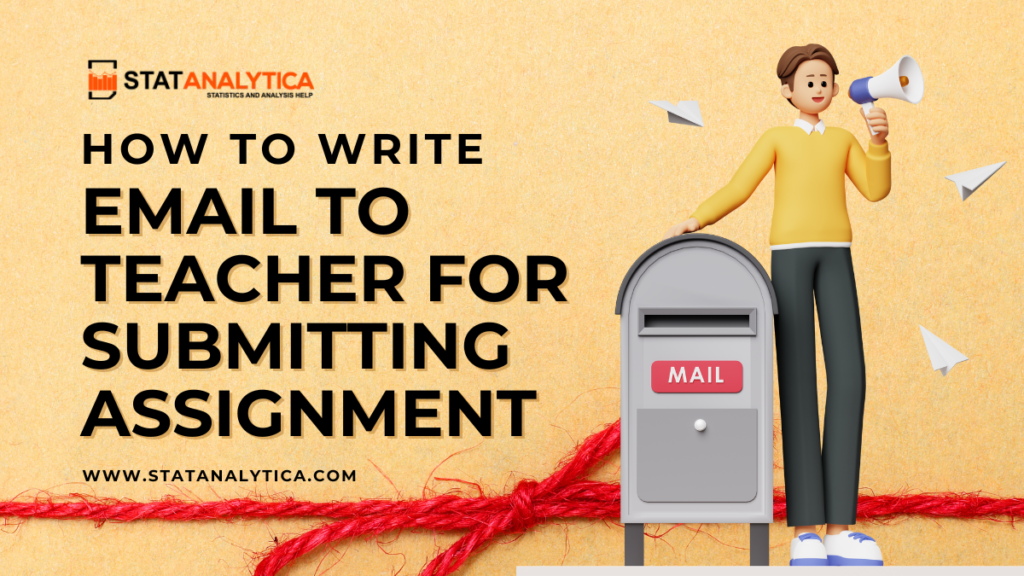
Hey there! Need help nailing that How To Write Email To Teacher For Submitting Assignment? We’ve got you covered! Crafting a winning email isn’t tricky. In this article, we’ll walk you through simple, effective steps to ace your communication game. From setting the tone to being clear and concise, we’ll break down each step, making it a breeze for you.
You’ll learn how to structure your email, what to include, and how to ask questions politely. No phrases or complex words here, just straightforward advice to help you craft an email that impresses your teacher and gets your assignment submitted hassle free. Let’s dive in and master the art of writing an email to your teacher for submitting assignments.
Student’s Perspective: Benefits Of A Good Email
Table of Contents
Writing a good email as a student has numerous advantages. It’s a crucial skill that helps in effective communication, building rapport with teachers, and ensuring clarity in your messages. Let’s explore its benefits:
- Clear Communication: A well-written email ensures your message is easily understood, avoiding confusion or misinterpretation. It helps in getting your point across succinctly.
- Positive Impression: Crafting a good email showcases your professionalism and commitment. It leaves a positive impression on teachers, potentially impacting their perception of you.
- Enhanced Relationships: Effective emails foster better relationships with teachers. It shows respect for their time and efforts, leading to a more conducive learning environment.
- Timely Responses: A good email prompts quicker responses from teachers, aiding in resolving queries or issues promptly.
- Improved Grades: Clear communication through emails ensures that instructions are understood correctly, potentially leading to better performance and grades.
- Professionalism: Mastering this skill early on helps develop professional habits, crucial for future academic and career endeavors.
- Confidence Boost: Writing good emails boosts your confidence in communicating effectively, a skill valuable beyond academic settings.
- Personal Development: It fosters self-expression, improving your ability to articulate thoughts and ideas clearly and respectfully.
- Long-term Benefits: Learning to write good emails sets you up for success in future academic and professional pursuits, a skill you’ll use throughout life.
How To Write Email To Teacher For Submitting Assignment?
Writing an email to a teacher for submitting an assignment can be a task full of nervousness, especially if you’re not sure how to approach it. When it comes to submitting assignments via email to your teacher, a clear and respectful approach can make all the difference. Here’s a simple guide on how to write email to teacher for submitting assignment:
Step 1: Subject Line Clarity
Ensure your subject line clearly states your purpose for writing the letter, including details like the assignment title and your name. For instance, “ Submission of [Assignment Title] by [Your Name]. ” The subject line is crucial—it helps your teacher identify your email easily among others. Include specific details to avoid any confusion.
Step 2: Polite Greeting
Start your email with a humble and polite greeting addressing your teacher by their title and name, such as “ Dear Professor [Last Name]” or “Hello Ms./Mr. [Last Name]. ” A respectful greeting sets a positive tone for your email, showing courtesy and professionalism.
Step 3: Clear Assignment Details
Clearly mention the assignment details, such as the course name, assignment title, and submission date. Provide any specific instructions or formats requested by the teacher.Being clear about the assignment details helps your teacher quickly understand what you’re submitting and by when, reducing any confusion.
Step 4: Attach or Link Assignment
Attach the assignment document or provide a secure link for your teacher to access the file easily. Attaching the file ensures your teacher can view your work promptly without any difficulty in accessing it.
Step 5: Openness to Feedback
Express your openness to feedback or any revisions your teacher might suggest, showing your willingness to improve.Being open to feedback demonstrates your commitment to learning and improving your work.
Step 6: Gratitude and Closing
Conclude your email with a polite thank you, expressing gratitude for your teacher’s time and consideration.A courteous closing acknowledges your teacher’s efforts and leaves a positive impression.
Remember, clarity, respect, and a willingness to communicate effectively are key when writing an email to submit your assignment to your teacher.
Top 10 Do’s And Don’t To Consider When Writing Mail To Teacher
Here in this part we have listed top 10 do’s and don’t to considered while writing a mail and they are as:
Top 10 Do’s
- Be polite and respectful in your tone.
- Use a clear and descriptive subject line.
- Address the teacher with their appropriate title and name.
- Provide specific details about the assignment.
- Attach or link the assignment file clearly.
- Express gratitude for their time and guidance.
- Proofread your email for errors before sending.
- Follow any formatting or submission guidelines.
- Be open to feedback and revisions.
- Sign off with a courteous closing.
Top 10 Don’ts
- Don’t use informal language or slang.
- Avoid using text message abbreviations.
- Don’t forget to include necessary details about the assignment.
- Avoid sending emails without a subject line.
- Don’t send emails with unclear or irrelevant content.
- Avoid attaching the wrong file or an incomplete assignment.
- Don’t expect an immediate response; allow time for the teacher to reply.
- Avoid being demanding or impatient in your tone.
- Don’t forget to run a proper spelling and grammar check .
- Avoid forgetting to thank the teacher for their time and consideration.
In wrapping up,after seeing how to write email to teacher for submitting assignment we can say writing a good email to submit assignments isn’t just about following rules; it’s about building respectful communication. A clear subject line and polite greeting set the tone. Sharing assignment details and attaching files help your teacher understand what you’re submitting. Being open to feedback shows you’re eager to learn. Finally, closing with a thank-you wraps things up nicely.
Remember, it’s not just about sending an email, it’s about making a good impression and showing respect. By following these steps, you’re not just submitting an assignment, you’re showing your teacher that you care about your work and their time. Keep it clear, keep it respectful, and keep on learning!
Related Posts

7+ Tips On How To Get Higher Grades In Exams In 2023

How to Write a Research Paper- A guide From Professionals

IMAGES
VIDEO
COMMENTS
What to Include in The Email to Your Teacher About Homework. Subject Line: Be specific and concise, e.g., "Question About [Assignment Name] Due [Date].". Greeting: Address your teacher formally, using "Mr./Ms./Mrs. [Last Name].". Introduction: Start by introducing yourself, especially if it's early in the school year.
2. Example email to a teacher about a late assignment. Dear [Teacher's Name], I apologize for submitting my assignment late. Unfortunately, unforeseen circumstances arose that prevented me from completing it on time. I understand the importance of timely submissions and take full responsibility for my actions.
11. Addressing a Missed Deadline. 12. Inquiry About Letter of Recommendation. 13: Request for Clarification on Assignment. 14 Expression of Interest in a Subject Area. Email 15: Request for Feedback on Draft. Email 16: Explanation of Absence and Request for Missed Materials.
Use formal greetings and sign-offs. Set the tone for your teacher to take you seriously with a greeting that's formal and respectful. Starting an email with "Hey" is the opposite of that. A formal greeting such as "Dear Mr. Lee" or "Hi Professor Bonnell" is not just courteous but friendly.
Learning how to write an email to a teacher can be an intimidating task. Gain insight from our clear guide to writing an appropriate (and polite) email. ... Whether you've got a quick question, need to submit your homework, or have a concern about your child's class performance, writing an email to a teacher is an important skill. ...
Using the teacher or professor's name shows respect and personalizes the email, creating a connection. Make sure you've spell-checked the name. Examples: Hello Mr. Johnson, Dear Professor Meyers, To Whom it May Concern, Step 3: Introduce the Issue. A brief introduction is like a warm-up.
1. Repeat after me: an email is not a text message!!! 2. Repeat after me: an email is not a novel or an epic poem. 3. Always enter in a subject line. Never leave this field blank. Keep it short and to the point, basically like giving your email a "title.".
8. End the email. There are many ways to end most emails, but you should always end emails to teachers with some variation of "Thank you," on its own line and then your name on a separate line. Possible substitutions for "Thank you" include "Sincerely", "Regards", and "Best".
How to send email to teacher about homework. Flowrite is an AI email writer that turns short instructions into ready-to-send emails and messages across your browser. Our smart template uses artificial intelligence to adapt to the situation and generate unique emails and messages, taking into account the recipient and previous message: ...
For example, you can greet a teacher with a "Hello" or a "Good afternoon.". Remember to add their title and last name. Avoid writing the email the same way you would text your friends, as it's not appropriate, even if you're friendly with your teacher during the class. There's no need to use abbreviations, and make sure to use ...
An email to a teacher should have a clear purpose. It should be written in a polite and professional tone. Be sure to open with a proper greeting and sign off with your name. Here are 14 tips for writing a good email to a teacher.
English teachers like that. Show some concern for the person reading the email: I hope you are having a good day. Remind your teacher how he knows you: I'm in your Monday 8-11 class. Say why you are writing your email: I am writing this email to tell you about a problem I am having and to ask you for your help.
Step 1: Determine the Purpose of Your Email. Step 2: Choose a Clear and Concise Subject Line. How to write an email to a teacher | Examples of subject lines. Step 3: Use a Professional Greeting. Step 4: Introduce Yourself. Step 5: Clearly State the Purpose of Your Email. How to write an email to a teacher | Examples of stating your request.
Write the proper name of your teacher, and a comma should follow it. Do not use informal words like 'hey, 'what's up'. Always use Dear Professor (last name). One more thing you have to remember: don't call your teacher with his or her first name unless they allow you to do so. Write your email in a polite form.
Start by using the correct title and surname. If you are unsure about how to address your teacher, it's best to use a formal title such as "Professor," "Doctor," or "Mr./Ms./Mrs." followed by their last name. For example, "Dear Professor Johnson" or "Hello Dr. Smith.".
Ensure you have a good reason for emailing. Use their school email account. Choose the right time to email a teacher. Craft a detailed subject line. Greet a teacher respectively. Be concise and clear. Format your email for better readability. Be polite and show gratitude. Label any attached files properly.
Email Etiquette: Teaching Students How to Email a Teacher. Email etiquette can be one of the most beneficial writing lessons of the school year. Students make great gains in a short amount of time. Consider…. From: [email protected]. To: [email protected].
Students: keep your audience in mind. After talking to five Whitman teachers, The Black & White compiled these tips to help students write better, more effective emails to teachers. Tip #1: Be respectful. The most important thing to remember in email writing is to be professional and respectful. Teachers are taking time out of their day to read ...
Sometimes you may need to add an attachment to your email, like if your child is out sick and you need to submit their makeup classwork. Make sure your email mentions any attachments, and name each attachment appropriately. Also, remember that most email servers allow a maximum of 25 MB per attachment. Sending a link to a cloud drive is a great ...
1. How to write an excuse email to professor example. Dear Professor (name), My name is (your name), and I'm in your (insert details) class. First, I would like to apologize personally and explain why I have been unable to (insert what you need an excuse for). II would like to reassure you that this won't happen again.
2. Open with a professional greeting. Address the teacher or professor politely by their title and last name on the first line of your email. Avoid using the instructor's first name (unless you're on a first-name basis) and stick with a formal greeting like "Dear" or "Good morning.". [2] "Good morning, Mr. Dickson,".
Hi [Name], Good morning [Name], Good evening [Name], Use formal closing lines. Always include a send-off, especially in your first email. "Sincerely" is always a good option. "All the best" and "best regards" are also formal, appropriate options. Always include greetings and closings to make a respectful and courteous impression.
Step 2: Polite Greeting. Start your email with a humble and polite greeting addressing your teacher by their title and name, such as " Dear Professor [Last Name]" or "Hello Ms./Mr. [Last Name]. " A respectful greeting sets a positive tone for your email, showing courtesy and professionalism.
Meanwhile, while fewer faculty members used AI, the percentage grew to 22% of faculty members in the fall of 2023, up from 9% in spring 2023. Teachers are turning to AI tools and platforms ...
We have carefully considered the questions and issues raised by our partners through our call centers and email, listening sessions, direct engagement, and other means of outreach. The Technical FAQ and Known Issues documentation contains the status of many of those issues. Going forward, we will continue to quickly identify, communicate about ...
This electronic announcement details the school- or state-specific data file that will be delivered to Student Aid Internet Gateway (SAIG) mailboxes this week to assist schools and states to further identify additional FAFSA records for which they can package aid. Each record will include applicant and contributor identifying information ...
Early childhood teacher cover letter template. Here is a cover letter template you can use to create your own cover letter: [Your Name] [Your Address] [City, State] [Your Email] [Today's Date] [Recipient's Name] [Recipient's Company] Dear [Hiring Manager's Full Name], As a dedicated and experienced early childhood teacher, I am excited to apply ...